



The Hologram is a viral distribution system for non-expert healthcare. Its protocol ensures that all caretakers are cared for, and regards properly supporting someone else’s wellbeing as therapeutic in itself.
This project was developed by a group of exhausted and anxious US artists, organizers and healers who experienced housing insecurity, inconsistent healthcare and massive debt, forced to scrounge and scam for care in between gigs.
The Hologram now lives on by different names with and through these people in venues all over the world. This workshop is aimed at anyone who is interested, and whose precariousness and fear of the (non-)future is the most reliable part of their life.
It is especially aimed at those whose waged or unwaged work is to transform the imagination (including artists, organizers, teachers, and activists). The wish is for all participants to connect to an “intentional community in exile” by learning to trust others in the same situation, and to rely on them for help navigating a world based on the capitalist sabotage of our health and thriving.
In a series of four free evening sessions, we will practice and discuss social skills, values, and priorities that are central to the Hologram model. These are powers that we may have forgotten or sold while fighting for our individual financial survival.
The course will involve a collective exploration of participants’ health as a common phenomenon. Each person will leave the course empowered to assemble and participate in their own Hologram and to network it with others.
Please note The Hologram talk and workshops are now taking place online due to pandemic restrictions. Contact info@furtherfield.org if you need any further information or assistance.
About the course co-facilitators
Cassie Thornton is an artist and activist who makes a “safe space” for the unknown, for disobedience and for unanticipated collectivity. She uses social practices including institutional critique, insurgent architecture, and “healing modalities” like hypnosis and yoga to find soft spots in the hard surfaces of capitalist life. Cassie has invented a grassroots alternative credit reporting service for the survivors of gentrification, has hypnotized hedge fund managers, has finger-painted with the grime found inside banks, has donated cursed paintings to profiteering bankers, and has taught feminist economics to yogis (and vice versa). She has worked in close collaboration with freelance curators and producers including Taraneh Fazeli, Magdalena Jadwiga Härtelova, Dani Admiss, Amanda Nudelman, Misha Rabinovich, Caitlin Foley, and Laurel Ptak. Her projects, invited and uninvited, have appeared at (or in collaboration with) Transmediale Festival for Media Arts, San Francisco MoMA, West Den Haag, Moneylab, Swissnex San Francisco, Pro Arts Gallery & Commons, Dream Farm Commons, Furtherfield, Gallery 400, Strike Debt Bay Area, Red Bull Detroit, Elizabeth Foundation for the Arts, Flux Factory, Bemis Center for the Arts, Berliner Gazette and more.
Lita Wallis is a youth worker, organiser, and informal educator based in London. Whether in work or her personal life, Lita has spent much of her time experimenting with different shapes of supportive relationships (eg. cooperatives, triangles, flows and webs.) She is still working on ways to build sustainable support networks that challenge isolating social norms, and then how to commit to them in a social context that is so hostile to putting down roots. Four years ago she and two friends made a lifelong commitment to The Tripod, a platonic support system, which aims to provide much of the financial, emotional and housing support that many people end up relying on couple relationships for. She hopes to bring some learning from this experience, plus some seeds of inspiration from her work with young people and her avid sci-fi habit, to set founding Hologram members fourth in good stead.
The Hologram is part of Furtherfield’s three-year Citizen Sci-Fi programme crowdsourcing creative and technological visions of our communities and public spaces, together.
2020 is the year of Love Machines, nurturing living and machine systems for mutual care and respect on earth and beyond.
Join us in using play to design a utopian economy by coming to play Utopoly at Furtherfield Commons.
Utopoly is a tool for inquiry, reflection and idea generation. Its purpose is to generate alternatives to the neoliberal orthodoxy and address the social and ecological crises it creates. It uses a game as utopian practice to critique the state of society and engage in speculation about how to shape the future. Through improvisational play Utopoly provides that rare space for people to re-imagine society, where values, forms of exchange and social relations can be reconsidered and reconfigured. Players then interact with and evaluate the alternative social and political spaces that emerge.
Utopoly starts with a Future Workshop, a method developed by Robert Jungk in 1962 to re-engage people’s innate creative genius which had been suppressed by school, work and consumerism. This involves separate stages of critique, fantasy and implementation. It starts with a discussion and critical exploration around a selected topic or situation. Players critically engage with the now or what-has-become to then open up space for the future or the what-is-yet-to-become. They create fantasies of a utopian nature unconstrained by whether they can be realized or not. Desires, ideas, alternative values, attributes and features of a utopian future are discussed. Moving from the limits of knowing to the possibilities of the yet-to-be-known. This is the political space where the future is open and crucially not a continuation of the present.
The implementation stage involves a ‘hack’ of Monopoly, a popular game which in its original form in 1904 had a progressive and beneficial informative function, but now celebrates and normalises competitive accumulation and socially useless rentier behaviour.
Players discuss and decide which of the features of a utopian future they want represented in the game Utopoly. They determine how the new economy works and – by introducing alternative values, currencies and transactions – can inspire new ways of considering existing social norms. Players then collaborate in a contest against the prevailing crises bound by the neoliberal agenda.
By playing Utopoly participants have the opportunity to reflect on alternative realities and social relations. They can navigate and negotiate the various game features and experience what it is like to inhabit a world incorporating the new economic and social possibilities they have created. In addition, by providing a platform for beneficial expectations Utopoly cultivates the ‘education of desire’ for a better world.
Further information about Utopoly can be found in the following articles:
New School (New York) Public Seminar, Utopoly – A utopian design game
Furtherfield UTOPOLY – playing as a tool to reimagine our future: an interview with Neil Farnan
SEE IMAGES FROM THE PRIVATE VIEW
Octavia E Butler had a vision of time as circular, giving meaning to acts of courage and persistence. In the face of social and environmental injustice, setbacks are guaranteed, no gains are made or held without struggle, but societal woes will pass and our time will come again. In this sense, history offers solace, inspiration, and perhaps even a prediction of what to prepare for.
The Time Portals exhibition, at Furtherfield Gallery and online spaces, celebrates the 150th anniversary of Finsbury Park. As one of London’s first ‘People’s Parks’, designed for free movement and thought, it is the perfect location to create a mass investigation of radical pasts and futures, circling back to the start as we move forwards.
Each artwork invites audience participation – either in its creation or in the development of a parallel ‘people’s’ work – turning every idea into a portal to countless more imaginings of past and future urban green spaces and beyond.
Time Portals from Furtherfield on Vimeo.
An interactive wall depicting the urban green space of Finsbury Park as a machine for radical re-assemblage. The external billboard can be scanned with an Augmented Reality app to reveal the secret of realising progressive visions for the future. Scan the message in the Gallery to see the billboard image animated.
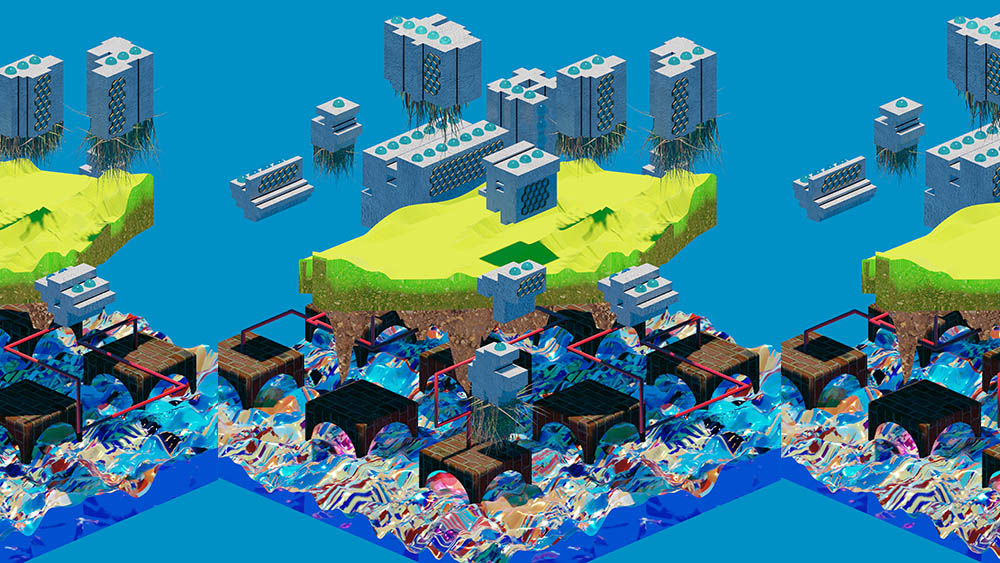
An interactive machine designed and built to respond to environmental change and inspire new rites for our troubled times. A slideshow of the machine as it is imagined and built will be presented alongside a ritualised unveiling in the Autumn.
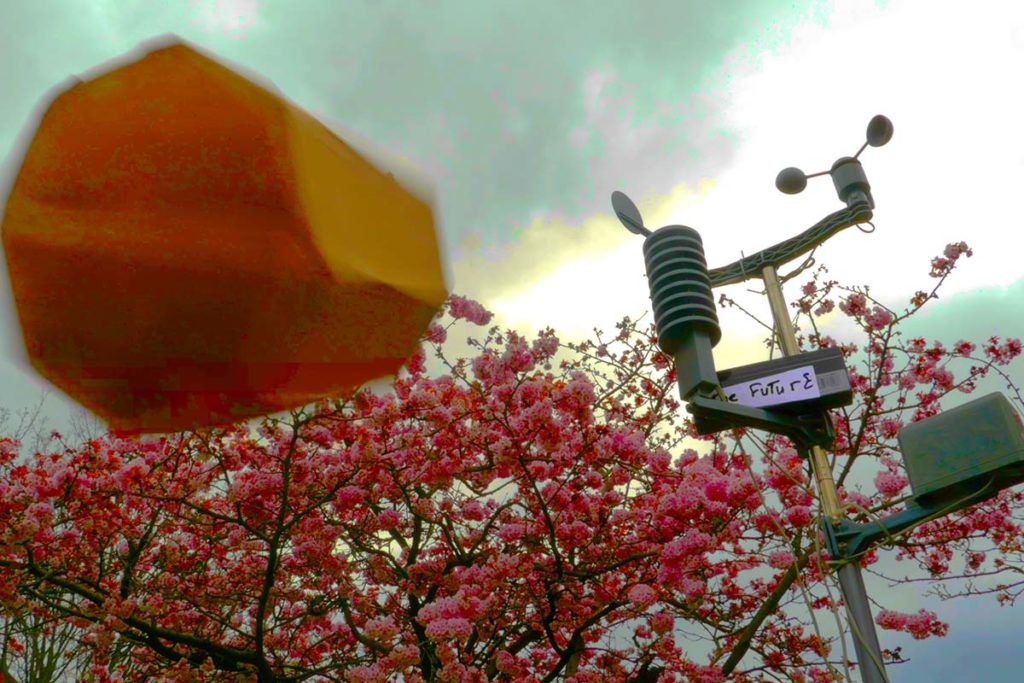
Join the Future Machine design team at Furtherfield Commons in Finsbury Park to build a new artwork that will help us to respond to environmental change…as the future unfolds. Sign up to take part in up to 4 workshops that involve talking, thinking & making, using interactive technology and scientific sensors, helping to design and build the Future Machine itself.
Workshop times/dates and sign-ups:
In collaboration with Amanda Wilson (MARA Project/Imperial College) and Professor Daniel Polani (University of Hertfordshire). Supported by EMAP, Arts Council England, and Haringey Council
An underwater robotic installation which explores what ‘life’ might mean in a future transformed by climate change and artificial intelligence. The work is based on new research into archaea, which are single-celled, ancient microbes that can survive in hot, polluted environments, combined with the latest innovations in machine learning. Now living at Furtherfield Gallery the “ArchaeaBot” is the ‘ultimate’ species for the end of the world as we know it.
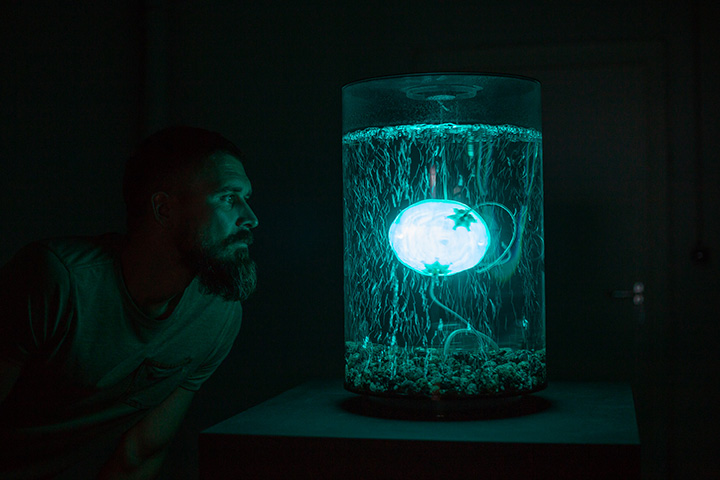
With creative team: Hugo Stanbury, Nick Lambert, Marius Matesan, Carl Smith, James E. Marks, Chris Szkoda
Through in-depth research James revisits a historical black woman who lived in the Finsbury Park area 150 years ago, embodies and reimagines her then and 150 years into the future. Produced together with Ravensbourne University PlayLabZ and Holotronica, experience time travel and holographic mixed reality at the Furtherfield Gallery throughout the summer.
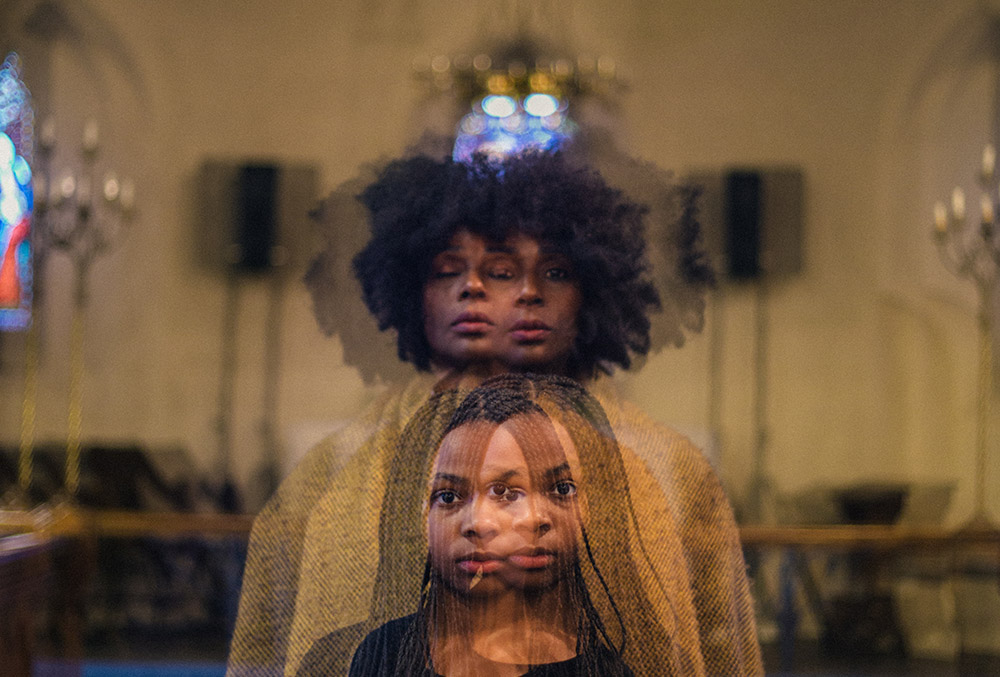
Part 2 of Circle of Blackness will be revealed later in the summer.
This video work is a complete rendition of the 1960s film version of HG Wells Novella re-edited by Thomson & Craighead into alphabetical order from beginning to end. In doing this, the artists attempt to perform a kind of time travel on the movie’s original timeline through the use of a system of classification.
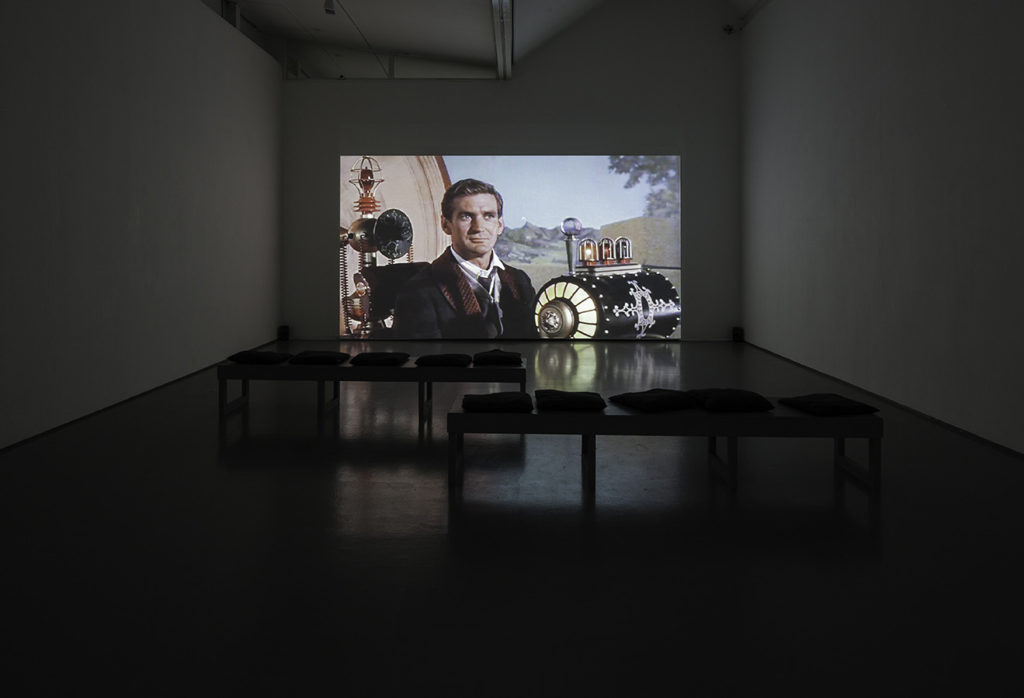
Future Machine Artwork Workshops:
26 Mar, 20 Apr, 11 May, 18 Jun, 13 Jul, Furtherfield Commons
Book Launch Event for Jugaad Time by Amit S. Rai:
27 Apr 14.00-16.00, Furtherfield Commons
Find a Line to Follow and Face The Future! ‘Walkshops’:
5 May 18 May, 10 Aug, Furtherfield Commons
Free, Fair, and Alive! A People’s Park Play Day:
10 Aug 10.00-17.00, Furtherfield Commons
Future of Money Workshops:
10 Aug, 10.00-17.00, Furtherfield Commons, other dates TBC,
Citizen Sci-Fi 3-Day Artworkers Lab Event:
14-15 Sept, time TBC, Furtherfield Commons
Future Machine Procession in Finsbury Park:
12 Oct, 3:00 pm – 8:00 pm, join at any point
This 3-year programme combines citizen science and citizen journalism by crowdsourcing the imagination of local park users and community groups to create new visions and models of stewardship for public, urban green space. By connecting these with international communities of artists, techies and thinkers we are co-curating labs, workshops, exhibitions and Summer Fairs as a way to grow a new breed of shared culture.
#CitSciFi – crowdsourcing creative and technological visions of our communities and public spaces, together.
Anna Dumitriu is a British artist who works with BioArt, sculpture, installation, and digital media to explore our relationship to infectious diseases, synthetic biology and robotics. She has an extensive international exhibition profile including ZKM, Ars Electronica, BOZAR, The Picasso Museum, The V & A Museum, Philadelphia Science Center, MOCA Taipei, LABoral, Art Laboratory Berlin, and The Museum of the History of Science Oxford. She was the 2018 President of the Science and the Arts section of the British Science Association and holds visiting research fellowships at the University of Hertfordshire, Brighton and Sussex Medical School, and Waag Society, as well as artist-in-residence roles with the Modernising Medical Microbiology Project at the University of Oxford, and with the National Collection of Type Cultures at Public Health England. Dumitriu is a renowned speaker and has presented her work at venues including TATE Modern, Princeton University, Imperial College, La Musee de la Chasse et de la Nature, The Mendel Museum and UCLA. Her work is featured in many books including “Bio Art: Altered Realities” published by Thames and Hudson in 2016 and many other significant publications across contemporary art and science including Artforum International Magazine, Leonardo Journal, The Art Newspaper, Art Quarterly, Nature and The Lancet. Dumitriu’s work has a strong focus on the ethical implications of emerging technologies drawing threads across time, exploring future scenarios by reflecting on the past.
Elsa James is a visual artist, activist and producer based in Southend-on-Sea, Essex, who grew up in west London during the 1970s and ’80s. Her solo practice encompasses lens-based performance, language and text, and recently the use of aural and the archive to explore regionality of race; black subjectivity; and the historical, temporal and spatial dimensions of what it means to be black in Britain. She is currently developing work exploring alienation and outsiderness experienced as a black woman living in Essex since 1999. Forgotten Black Essex (2018) embodies two place-specific narratives from our national archives of two overlooked, under-researched and recognised black women in Essex. Her social practice includes advocating for the inclusion of marginalised communities in the arts sector. New Ways of Seeing, Telling and Making (2018), a visual provocation and participatory lab at the Social Art Summit, asked questions about how we can ‘genuinely’ address barriers to participation and involvement in the arts for BAME communities. In 2015 she was commissioned to research the asylum and refugee community in Southend. This culminated in a 38-page report exposing the council’s lack of provision for the needs of asylum seekers, failed asylum seekers and refugees living in Southend.
Rachel Jacobs is an artist, researcher and games designer. She co-founded the artist-led collective Active Ingredient in 1996 and the commercial games company Mudlark Production Company in 2007. She completed a Doctorate in Computer Science in 2014. Rachel is a practising artist exhibiting nationally and internationally, and a Research Associate at the Horizon Digital Economy Institute, University of Nottingham. Her artworks include the award winning ‘Heartlands (Ere Be Dragons)’ one of the first mobile games that took place on city streets in Sao Paulo, Yokhama, Berlin, Paris, Cambridge, Bristol and Nottingham; ‘A Conversation Between Trees’, a touring artwork and schools exchange using environmental sensors to connect forests in the UK and Brazil; and ‘The Prediction Machine’, an interactive installation that predicts the future impacted by climate change. Rachel is currently developing a series of artists interventions ‘Creating Rituals for When The Future Comes’, alongside a mobile interactive artwork the ‘Future Machine’.
Dr Nick Lambert is Director of Research at Ravensbourne University London, where immersive environments and mixed reality experiences are being developed. He researches the application of technology in contemporary art and visual culture. He has written on the history of computer art and engaged with artists and theorists in this field. He has also created artworks for immersive environments including fulldome, and interactive exhibits.
James E. Marks, PsychFi – A natural born new media pioneer, award winning social video, & dimensional computing arts for good maker, curator & speaker. With 4 decades of hands-on experience & experimental knowledge collaborating on Brand / Crowd / Arts Council funded “Sub & Pop Culture Mixed Up Reality Experiences”. Recent collaborations include V&A, London Design Festival, Boomtown Fair, Mobile World Congress, Ravensbourne University, Bethesda, SubPac, Modern Panic, Sci-Fi-London & BBC Click
Marius Matesan is creating narratives using real and virtual installation art, noted mostly for his work on theatre stages across Europe and more recently for his Mixed Reality experiences. Mixing reality with the imaginary, using sound, projection mapping, spatial computing and virtual reality. His work revolves around pushing the boundaries of perception, awareness and reality, creating installations that are often addressing social issues with a psychedelic twist.
Alex May is a British artist creating digital technologies to challenge and augment physical and emotional human boundaries on a personal and societal level in a hyper-connected, software mediated, politically and environmentally unstable world. He works with light, code, and time; notably algorithmic photography, robotic artworks, video projection mapping installations, interactive and generative works, video sculpture, performance, and video art. Alex has exhibited internationally including at the Francis Crick Institute (permanent collection), Eden Project (permanent collection), Tate Modern, Ars Electronica (Austria), LABoral (Spain), the Victoria & Albert Museum, Royal Academy of Art, Wellcome Collection, Science Museum, Bletchley Park, One Canada Square in Canary Wharf, the Museum of Contemporary Art in Caracas (Venezuela), the Science Gallery in Dublin, Princeton University, University of Calgary (international visiting artist 2016), Texas A&M University, and the Beall Center for Art + Technology, University of California, Irvine. Alex is a Visiting Research Fellow: Artist in Residence with the School of Computer Science of University of Hertfordshire, and a Digital Media Arts MA sessional lecturer at the University of Brighton.
http://www.alexmayarts.co.uk
Antonio Roberts is a new media artist and curator based in Birmingham, UK. He uses technology-driven processes to explore issues surrounding open source software, free culture and collaborative practices. His visual and performance work has been featured at galleries and festivals including databit.me in Arles, France (2012), Glitch Moment/ums at Furtherfield Gallery, London (2013), Loud Tate: Code at Tate Britain (2014), glitChicago at the Ukrainian Institute of Modern Art in Chicago, US (2014), Permission Taken at Birmingham Open Media and University of Birmingham (2015-2016), Common Property at Jerwood Visual Arts, London (2016), Green Man Festival, Wales (2017) and Barbican, London (2018). He has curated exhibitions and projects including GLI.TC/H Birmingham (2011), the Birmingham editions of Bring Your Own Beamer (2012, 2013), µChip 3 (2015), Stealth (2015), and No Copyright Infringement Intended (2017).
Carl H Smith is Director of the Learning Technology Research Centre (LTRC) and Principal Research Fellow at Ravensbourne University London. His background is in Computer Science and Architecture. He has 17 years experience conducting R+D into the application of hybrid technologies for perceptual, cognitive and creative transformation. He has worked on a number of large-scale FP7 and Leonardo Life Long Learning European projects. He is currently working on 4 EU projects including the Horizon 2020 project ‘[WEKIT] Wearable Experience for Knowledge Intensive Training’ which aims to create ‘Wearable Experience (WE)’ – an entirely new form of media. His research interests include Embodied Cognition, Spatial Literacy, Perceptual Technology and Hyperhumanism. His other projects involve Context Engineering, Umwelt Hacking, Natural Media, Sensory Augmentation, Memory Palaces, Artificial Senses and Body Hacking. He is co-founder of the London Experimental Psychonautics Club and co-founder of the Cyberdelic Society. Both organisations explore the myriad of ways it is possible to produce and examine Altered States of Consciousness. He has previously worked at the Computing departments at London Metropolitan University, Glasgow University and Sheffield University. The Learning Technology Research Centre (LTRC) conducts design research into the application of information and communication technologies to augment, support and transform cognition.
Hugo Stanbury has worked in the event and entertainment industry for over a decade. Inspired most by the area where cutting edge technology is used for properties rather than purpose, he works hard to balance sound technical delivery with new creative concept. He currently works as Operations Director at Holotronica – the UK company behind Hologauze. Hologauze is the world leading gauze for holographic effects with clients from BMW to Beyonce. Holotronica are specialists in a range of holographic displays, analogue holography and 3D content.
Studio Hyte is a London based multidisciplinary design studio who place research and concept above medium. Working between graphic design, interaction and emergent forms of visual communication, we aim to create meaningful and thought provoking work. Formed of a small group of individual practitioners, Studio Hyte is the middle ground where all of our interests and practices meet. As such our collective practice and research covers a broad spectrum of topics including; language, inclusion & accessibility, egalitarian politics & alternative protest and technology & the human. With an emphasis on process, we often create critical narratives through our work in order to conceptualise through making. Collectively, our visual practice is a means through which we can plot out a conceptual landscape in order to understand and explore real-world scenarios. Studio Hyte works on self-directed research projects, commissions and client-led projects for a small pool of like minded organisations and individuals.
Chris Szkoda, Kaws Infinity – Games Designer/ VFX Artist, works on designing mixed/virtual reality apps for a social mixed reality experience playground at Ravensbourne University London. Keen to support social good & diversity projects, working directly with students and helping them make their creative ideas a reality. He has expertise in immersive technology, VR modelling and painting in Google Tilt Brush and MasterpieceVR software.
Jon Thomson (b. 1969) and Alison Craighead (b. 1971) are artists living and working in London. They make artworks and installations for galleries and specific sites including online spaces. Much of their recent work looks at live networks like the web and how they are changing the way we all understand the world around us. Having both studied at Duncan of Jordanstone College of Art in Dundee, Jon is Reader in Fine Art at The Slade School of Fine Art, University College London, while Alison is a reader in contemporary art and visual culture at University of Westminster and lectures in Fine Art at Goldsmiths University.
http://www.thomson-craighead.net/
Artists Idit Nathan and Helen Stratford are working with Furtherfield to create PLAY THEN NOW OR NEVER! a new playful App and map for Finsbury Park, and inviting you to help in the process.
Book now to join the artists to explore opportunities for free and creative play in Finsbury park. Walk, play and think in past, present and future spaces, in a ‘walkshop’ devised by the artists. Dice will roll, cards will solicit and props will inspire. The walkshops will inform the creation of playful prompts for PLAY THEN NOW OR NEVER! Finsbury Park’s newest and most playful digital mobile App, with its own map, that will reimagine the park and act as provocations for future park users.
Location:
Furtherfield Commons
269-271 Seven Sisters Road
Finsbury Park
N4 2DE
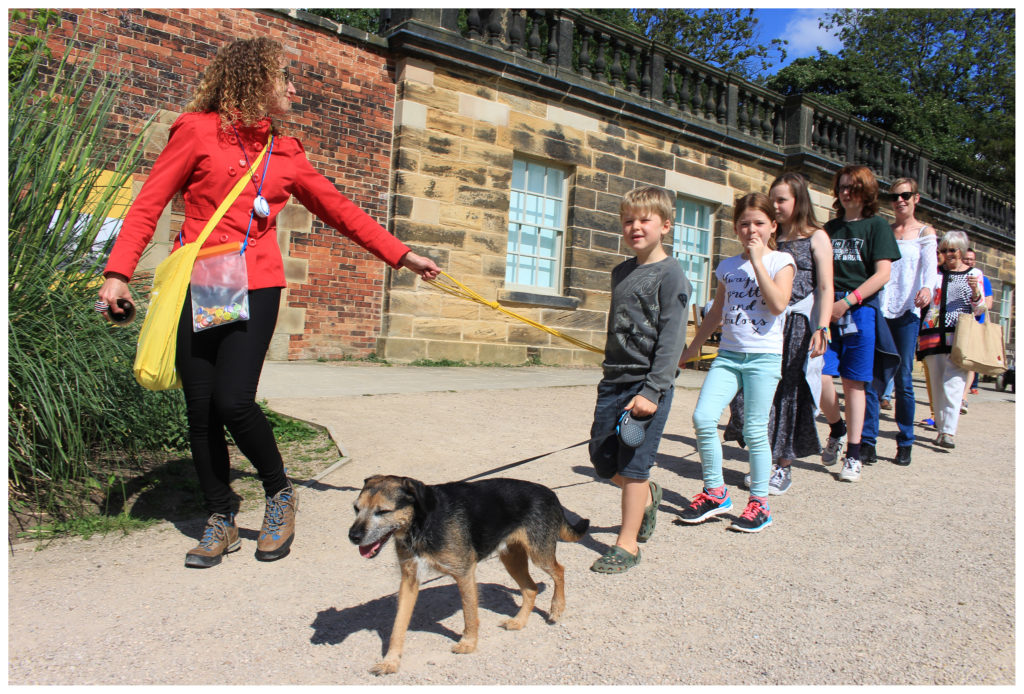
The walkshops are designed to bring together people of all ages and abilities – everyone is welcome! The group will journey through the park for approximately an hour then regroup at Furtherfield Commons for a recall and share session where refreshments will be provided.
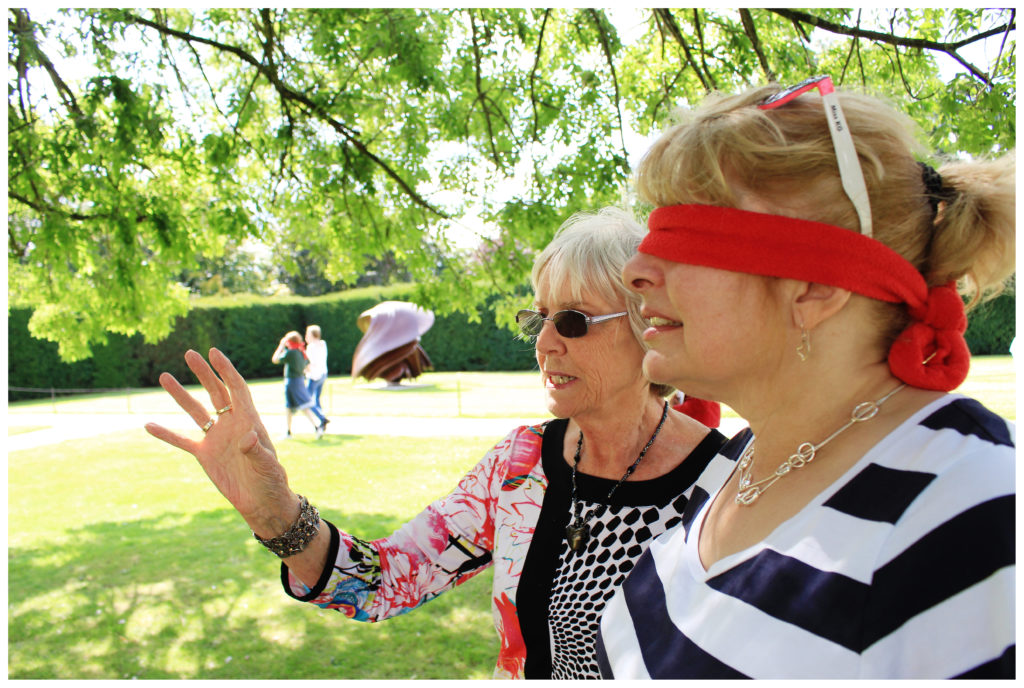
PLAY THEN NOW OR NEVER! is devised by artists Idit Nathan and Helen Stratford (Play Anywhere Now or Never!) who see play as a sophisticated yet highly accessible way to investigate ‘big’ and complex issues that relate to the way we move in and experience the world around us. Their work takes the form of site specific interventions that question and re-imagine these through the prism of play. To find out more about their work see their website.
PLAY THEN NOW OR NEVER is part of Furtherfield’s 2019 programme: Time Portals.
This 3-year programme supports our Platforming Finsbury Park initiative. Between 2019-2021 we will produce exhibitions and events that combine citizen science and citizen journalism by crowdsourcing the imagination of local park users and community groups to create new visions and models of stewardship for public, urban green space. By connecting these with international communities of artists, techies and thinkers we are co-curating labs, workshops, exhibitions and Summer Fairs as a way to grow a new breed of shared culture.
#CitSciFi – crowdsourcing creative and technological visions of our communities and public spaces, together.
The Time Portals exhibition, held at Furtherfield Gallery (and across our online spaces), celebrates the 150th anniversary of the creation of Finsbury Park. As one of London’s first ‘People’s Parks’, designed to give everyone and anyone a space for free movement and thought, we regard it as the perfect location from which to create a mass investigation of radical pasts and futures, circling back to the start as we move forwards.
Each artwork in the exhibition therefore invites audience participation – either in its creation or in the development of a parallel ‘people’s’ work – turning every idea into a portal to countless more imaginings of the past and future of urban green spaces and beyond.
For this Olympic year we will consider the health and wellbeing of humans and machines.
For this year of predicted peak heat rises we will consider how machines can work with nature.
On a blustery cold and wet Sunday in the build up to Christmas I joined a group of people at Furtherfield Commons to discuss the future of Finsbury Park. I finally arrived after prowling around their darkened Gallery in the centre of the park, only to discover the event was being hosted in their other space in the far southeastern corner of the park. This brief detour gave me a moment to breathe in one of my local parks and I experienced a familiar feeling of vulnerability as the night drew in and cold drops of rain started to make themselves felt. The few brave families and exercisers were beginning to retreat as I crossed the open stretch of field that runs parallel to the roaring Seven Sisters Road. Drawn by the welcoming light coming from the building in the small gardens behind the legendary Rowans Ten Pin Bowling and guided by the sound of the drumming, a regular feature of this corner of the park, I entered the workshop and was greeted with mince pies, tea and other goodies, and met the 11 other workshop participants.
Timed to coincide with the 150th anniversary of Finsbury Park, this workshop for local residents, aimed to tap into our experiences and imaginations to generate future visions of the park. The event was led by Dr Rachel Jacobs, who is a local with a special affection for the park, and she started by sharing it’s stories and describing some of the features that are no longer in existence including a bandstand and the many trees that have been removed over the years.
We started by identifying features of the park that we would like to ‘lose’ and those we wanted to ‘protect’. Answers were varied but along similar themes. Many people shared a desire to preserve the trees and if possible, have more. The lake featured prominently with many people wanting to maintain the space and the sanctuary it provides for birds. Rose, one of my fellow workshoppers, gleefully called for those people who feed bread to the ducks to be poisoned.
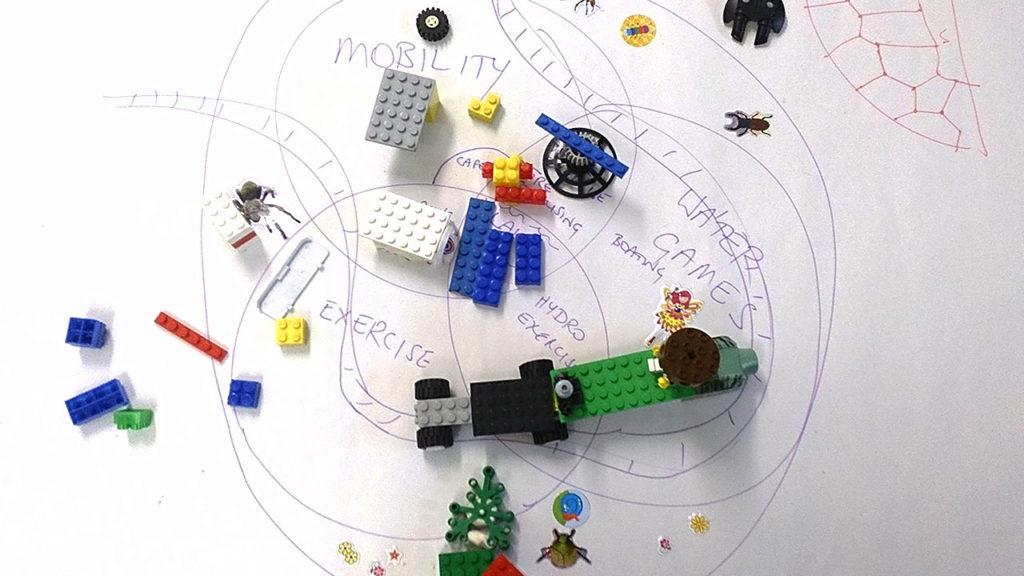
The underground reservoir, a cathedral-like temple to water supply was hailed as a hidden gem that could be utilised as a space during the colder months by Polly a local resident and manager of Space4. Simon, Chair of Friends of Finsbury Park, suggested we consider uses for Manor House Lodge (another building that had escaped my attention). Zeki prioritised the the rocks in the park for protection – especially at the amphitheatre space beside the play park. There were wistful expressions of personal connections to conkers, squirrels and swans. The things that people wanted to lose were more elusive: the atmosphere that the park creates at night; its association with crime and a lack of safety. Gab who overlooks the park from his 8th floor flat, feels the park can be scary and in his words, sometimes ‘sly’. Removing the fences was suggested as a possible remedy.
Next, we were introduced to an initially bemusing process based on Play Your Place, designed by artists Ruth Catlow and Mary Flanagan, to introduce playful and game-like activities to public consultation. We were each asked to select different cards with random words that we were told would help us to disrupt our conventional view of problem solving. The cards were divided into provocative statements, for example mine were: ‘London is no longer’ and ‘getaway car’. Then a spinning wheel contained words associated with game features, like ‘mission’, ‘protagonist’, ‘goal’ or ‘reward’. After drawing or writing out our scenarios based on the random words we had to pick a segment of the wheel in which to place our ideas.
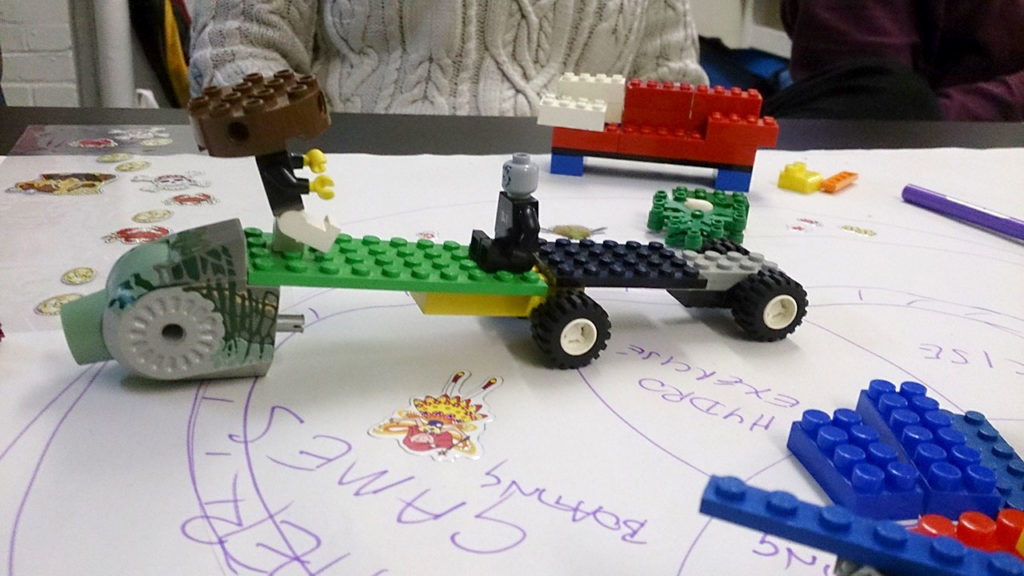
I asked if London is no longer, why is that so? Perhaps the park has eaten London. I was making the park the protagonist, the hero of the story. My ‘getaway car’ card prompted me to imagine Finsbury Park criss-crossed by many roads. So what if a part of the park could move very slowly, a moving park that people could take in the rest of the park from and jump on and off.
Zeki, one of the youngest participants had the cards ‘maps‘ and ‘someone caring for the park’ they assigned it the wheel word ‘reward’. He imagined the rocks in the park could become an area where people could come and paint and draw on the rocks. People will be able to look at the drawings and climb on the rocks. He said this suited ‘reward’ because you get a nice place.
Finally we worked with lego and plasticine, felt and coloured paper, to make a representation of our scenarios. Time flew by before we were then asked to talk about what we had created.
Simon and Talal ended up using a lot of lego. They said they weren’t that confident ‘creating’ but their riotous explosion of lego pieces described the Finsbury Park Lodge with lots of tropical trees growing around them. They included a clocktower which they felt the park needed. Ominously on the edge of their diorama there was, in their words: ‘the threat of a forest fire’.
Ilenia and Gab created intricate visions of the park modelled from tiny pieces of plasticine. Ilenia created crosses to represent all the buildings that she was going to destroy. She said “All the fences will be replaced by nice trees. The lake will be larger than it is now. There will be more people using the park.” Gab described the a tree as becoming “a colourful multi-form creator. It will be very friendly and very different from normal. Everything will be very colourful and this will be linked to representing climate change.” Emma who earlier in the workshop explained her love of conkers ended up building robot conkers.
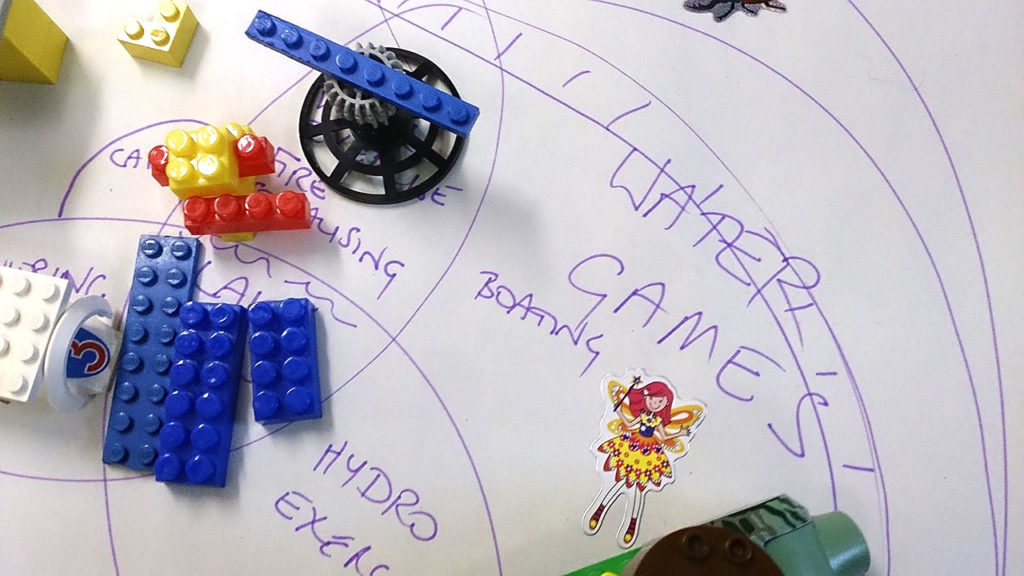
The outcomes were unexpected and realised in a wonderfully ad hoc way with a rich mix of ideas. Rachel and the Furtherfield team were on hand to support and provide more insight. Although the process of drawing cards and selecting from a wheel was initially quite perplexing, staying with the uncertainty of the process meant that we came up with ideas that were novel and unhindered by more formal or conservative notions of preserving or enhancing Finsbury Park. The two hour time limit, meant that everything moved along at pace that kept the idea generation restless. I believe I speak for all who took part in anticipating the results of the wider project.
What can possibly be made from such a kaleidoscope of raw material, I wondered on my way home in the pouring rain? Perhaps my plant car or Emma’s robot conkers will see the light of day or the darkness of the underground reservoir.
Futurescapes is an Innovate UK Audience of the Future Design Foundations project that uses Finsbury Park as a test case to examine the commercial potential for using immersive experiences as a tool for collaborative placemaking for public spaces and integrated public services. Furturescapes is a partnership project with Furtherfield, The Audience Agency and Wolf in Motion.
ART AFTER MONEY, MONEY AFTER ART is a workshop with Max Haiven, author of Art After Money, Money After Art: Creative Strategies Against Financialization.
In a world turned into a casino is it any wonder that corporate gangsters increasingly run the show? What are the prospects for a democratization of the economy when new technologies appear to further enclose us in a financialized web where every aspect of life is transformed into a digitized asset to be leveraged? Ours seems to be an age when art seems helpless in the face of rising authoritarianism, or like the plaything of the worlds speculator-plutocrats, and age when “creativity” has become the buzzword for the violent reorganization of work and urban life towards an endless “now” of competition and austerity.
And yet… we are witnessing an effervescence of imaginative struggles to challenge, hack and reinvent “the economy.” Artists, technologists and activists are working together not only to refuse the hypercapitalist paradigm but reinvent the methods and measures of cooperation towards different futures. This workshop brings together many of these protagonists and their allies for a discussion on the occasion of the publication of Max Haiven’s new book Art After Money, Money After Art: Creative Strategies Against Financialization.
Haiven will kick off the conversation with a short presentation of key themes in the book as they impinge upon the question of working at the intersection of “art” and new technologies (including but not limited to blockchains) to create alternative economic paradigms. The central question is, to what extent can these efforts surpass the (important) desire to redistribute wealth in a world of growing inequalities and, additionally, aim for a much more profound and radical collective reimagining of who and what is valuable.
Austin Houldsworth
Dan Edlestyn
Brett Scott
Cassie Thornton
Kate Genevieve
Emily Rosamond
Jonathan Harris
Ruth Catlow and Martin Zeilinger will chair discussions and the event is sponsored by Anglia Ruskin University
Pluto Press are happy to offer a Furtherfield discount on the book. Add Art After Money to the cart and use the discount code ART15 to get the book at £15.
SEE IMAGES FROM THE PRIVATE VIEW
Would you like to monetise your social relations? Learn from hostile designs? Take part in (unwitting) data extractions in exchange for public services?
Examining the way that the boundaries between ‘play’ and ‘labour’ have become increasingly blurred, this summer, Playbour: Work, Pleasure, Survival, will transform Furtherfield Gallery into an immersive environment comprising a series of games. Offering glimpses into the gamification of all forms of life, visitors are asked to test the operations of the real-world, and, in the process, experience how forms of play and labour feed mechanisms of work, pleasure, and survival.
What it means to be a worker is expanding and, over the last decade, widening strategies of surveillance and new sites of spectatorship online have forced another evolution in what can be called ‘leisure spaces’. From the self-made celebrity of the Instafamous to the live-streaming of online gamers, many of us shop, share and produce online, 24/7. In certain sectors, the seeming convergence of play and labour means work is sold as an extension of our personalities and, as work continues to evolve and adapt to online cultures, where labour occurs, what is viewed as a product, and even, our sense of self, begins to change.
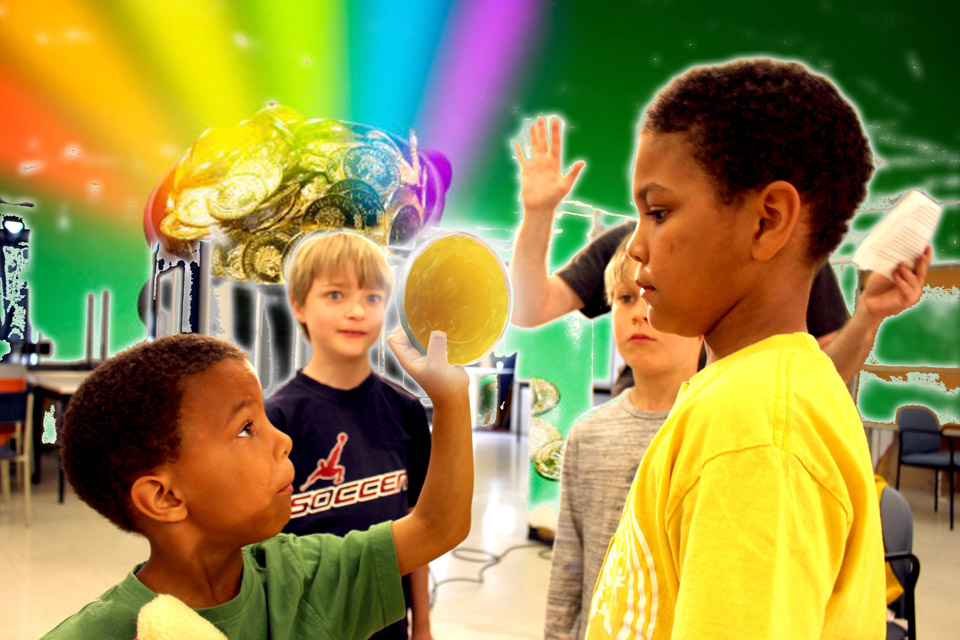
Today, workers are asked to expand their own skills and build self-made networks to develop new avenues of work, pleasure and survival. As they do, emerging forms of industry combine the techniques and tools of game theory, psychology and data science to bring marketing, economics and interaction design to bear on the most personal of our technologies – our smartphones and our social media networks. Profiling personalities through social media use, using metrics to quantify behaviour and conditioning actions to provide rewards, have become new norms online. As a result, much of public life can be seen as part of a process of ‘capturing play in pursuit of work’.
Although these realities affect many, very little time is currently given over to thinking about the many questions that arise from the blurring between work and play in an age of increasingly data-driven technologies: How are forms of ‘playbour’ impacting our health and well-being? What forms of resistance could and should communities do in response?
To gain a deeper understanding of the answers to these questions, we worked with artists, designers, activists, sociologists and researchers in a three-day co-creation research lab in May 2018. The group engaged in artist-led experiments and playful scenarios, conducting research with fellow participants acting as ‘workers’ to generate new areas of knowledge. This exhibition in Furtherfield Gallery is the result of this collective labour and each game simulates an experience of how techniques of gamification, automation and surveillance are applied to the everyday in the (not yet complete) capture of all forms of existence into wider systems of work.
In addition to a performance by Steven Ounanian during the Private View, the ‘games’ that comprise this exhibition are:
Lab session leads and participants: Dani Admiss, Kevin Biderman, Marija Bozinovska Jones, Ruth Catlow, Maria Dada, Robert Gallager, Beryl Graham, Miranda Hall, Arjun Harrison Mann, Maz Hemming, Sanela Jahic, Annelise Keestra, Steven Levon Ounanian, Manu Luksch, Itai Palti, Andrej Primozic, Michael Straeubig, Cassie Thornton, Cecilia Wee, Jamie Woodcock.
Curated by Dani Admiss.
Concept development Dani Admiss and Cecilia Wee.
Mask Making for Children
Sunday 22 July and 12 August 2018, 11:00 – 16:30
Furtherfield Gallery
FREE
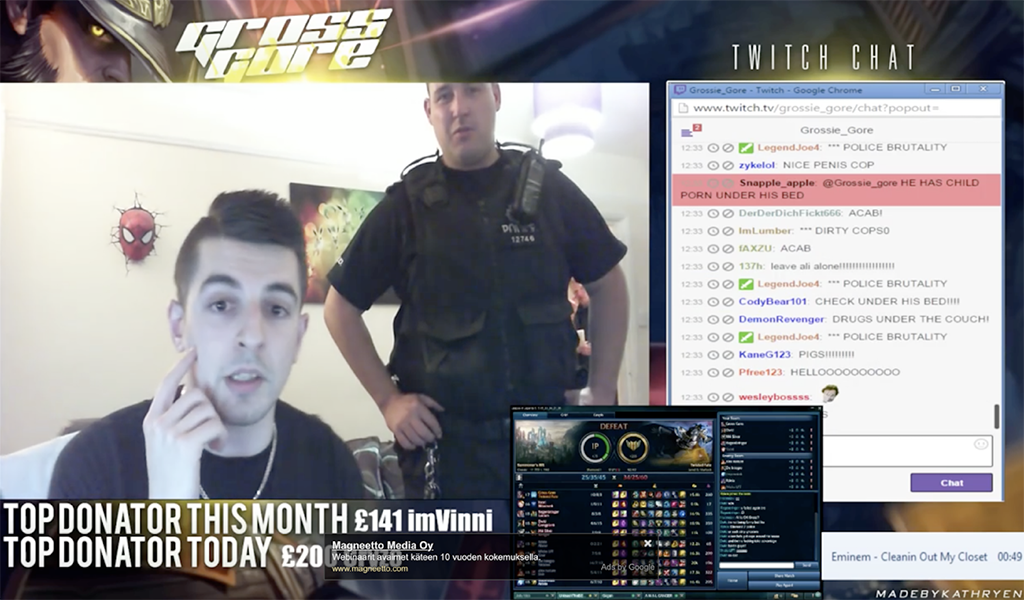
Dani Admiss
When I was 16 I was in a band. I couldn’t sing that well so I used to write lyrics (about vampires) and put them into Babelfish to translate them into French thinking it made me sound automatically cooler.
@daniadmiss
Kevin Biderman
First met you in a dial up world; green block letters on a black screen. Later we traversed through neon colours, pixelated images and imperfect designs. I always knew you were an army brat born out of apocalyptic fears but I never thought you’d turn your back on the counter-culture who raised you. Maybe there will be a third act…
@act3
Marija Bozinovska Jones
The internet has concurrently enhanced and diminished life, yet I appear no longer able to recall life before it. Adding to Jameson’s quote: it is easier to imagine the end of the world, than the end of TECHNOcapitalism.
Ruth Catlow
I am a recovering Web Utopian – decentralised infrastructure does not, it turns out, lead automatically to decentralised power. However i am still most excited by art that happens in wild flows, through collaboration on open channels, rather than being owned, certified and traded like dead matter. I am Ruth and I am one of the voices and pairs of eyes.
@furtherfield
Maria Dada
I regularly translate whole books from German to English using Google Translate. I then take the transcripts and print them using lulu.com. I take pride in the design of the covers for each book. Not all of them are unreadable but most of them just sit on my shelf untouched.
@mariadada
Beryl Graham
I confess:
To buying a mobile phone so that I could text my sweetie.
To being mildly obsessed with weather apps that work best in the North.
To using online dating 15 years ago. The respectable Guardian rather than Tindr of course – hey I’m not an animal.
@berylgraham
Miranda Hall
After school, my friend and I would take screenshots of penises on ChatRoulette then save them in a desktop folder on the family computer called ‘cool fish’
@Miranda__Hall
Arjun Harrison-mann
For Much Longer than I Would Care to Admit, Every Since I Got Msn at the Age of 12, My Msn Profile Picture Was (and I Just Checked, Still Is), a Photoshopped Collage of Michael Jordan.
@arjun_harrisonmann
Maz Hemming
When I was 11, lying about my age to sign up on msn chat to chat about neopets, I ended up as one of the chatroom moderators. Which sometimes ended up with me leaving the window open to idle overnight (or the room would close). On the bonus side when my parents ended up with a bill at the end of the month of £200 (which I didn’t know would happen) we did get broadband. Much cheaper.
@MazHem_
Robert Gallagher
The unread emails in my inbox currently outnumber my Twitter followers by a factor of 47.7461024499 to 1.
@r_gealga
Sanela Jahić
Once my inbox got flooded with promotions of an online store. So my boyfriend and I composed a simple bot, which took random quotes from our sci-fi eBooks collection and posted them as customer reviews on their product pages.
Annelise Keestra
Until more recently than I would admit, I genuinely didn’t think there was any correlation between the file size of a download and data use. As if, there were two kinds of “GB”. Please don’t judge me.
@aut0mne
Steven Levon Ounanian
I think the internet loves me, but just doesn’t know how to show it.
@levontron
Manu Luksch
Our dream rewired. Our powers of prediction grow with every new circuit crammed in. Leap into tomorrow – one trillion calculations a second. And it grows more powerful, becomes smaller. Smart, mobile, personal. Today – in our pockets. Tomorrow – woven into our bodies. Create and share, everything, everywhere. Life in the cloud… with a chance of blue skies. Our time is a time of total connection. Distance is zero. The future is transparent. To be, is to be connected – the network seeks out everyone.” (Dreams Rewired; 2015 – my latest feature film about our hopes and fears of being hyper-connected).
@ManuLuksch
Itai Palti
I started visiting an architecture news forum as a teenager, excited about updates on local building projects. I still visit regularly for the updates, but also make sure to check on an exceptionally cringeworthy, decades-long feud between a couple of regular posters. I think they’d really miss each other if it all stopped.
@ipalti
Joana Pestana
Back in 1999, frustrated, I nurtured no love for my iMacG3 as I had to bare with 1-song-download-per-week for not having Napster.
@joanampestana
Michael Straeubig
Before social networks and Reddit, newsgroups were the places for online discussions. Catering to my interests was comp.ai.philosphy, a group notorious for debates going haywire.
Once I had a very heated discussion with someone I considered to be an immature and irrational teenager. It turned out it was a professor in Artificial Intelligence.
@crcdng
Cassie Thornton
I own/owned these URLs: bizzykitty.com, temporaryartbeautyservices.biz, infinitemuseum.com, evilarchitexture.net, teachingartistunion.org, sfluxuryrealestatejewelry.org, mastercalendar.biz, debtimage.work, institutionaldreaming.com, poetsecurity.net, universityofthephoenix.com, debt2space.info, secretchakra.net, wombco.in, givemecred.com, wealthofdebt.com, strikedebtradio.org, matterinthewrongplace.info, futureunincorporated.com, feministeconomicsdepartment.com, projectherapy.org, and many more I will never remember.
@femnistecondept
Cecilia Wee
The first time I went on the internet was about 1 year after Cyberia cafe opened in central London. I somehow convinced my mum to make a detour from a shopping trip so I could go online to look at 2 websites. Everyone else there was working very hard.
@ceciliawee
Jamie Woodcock
I decided it would be a fun idea to learn to play League of Legends as part of the fieldwork for an esports project. However, I was so bad at it that instead I had to study before playing, reading up on guides and watching streams/videos.
@jamie_woodcock
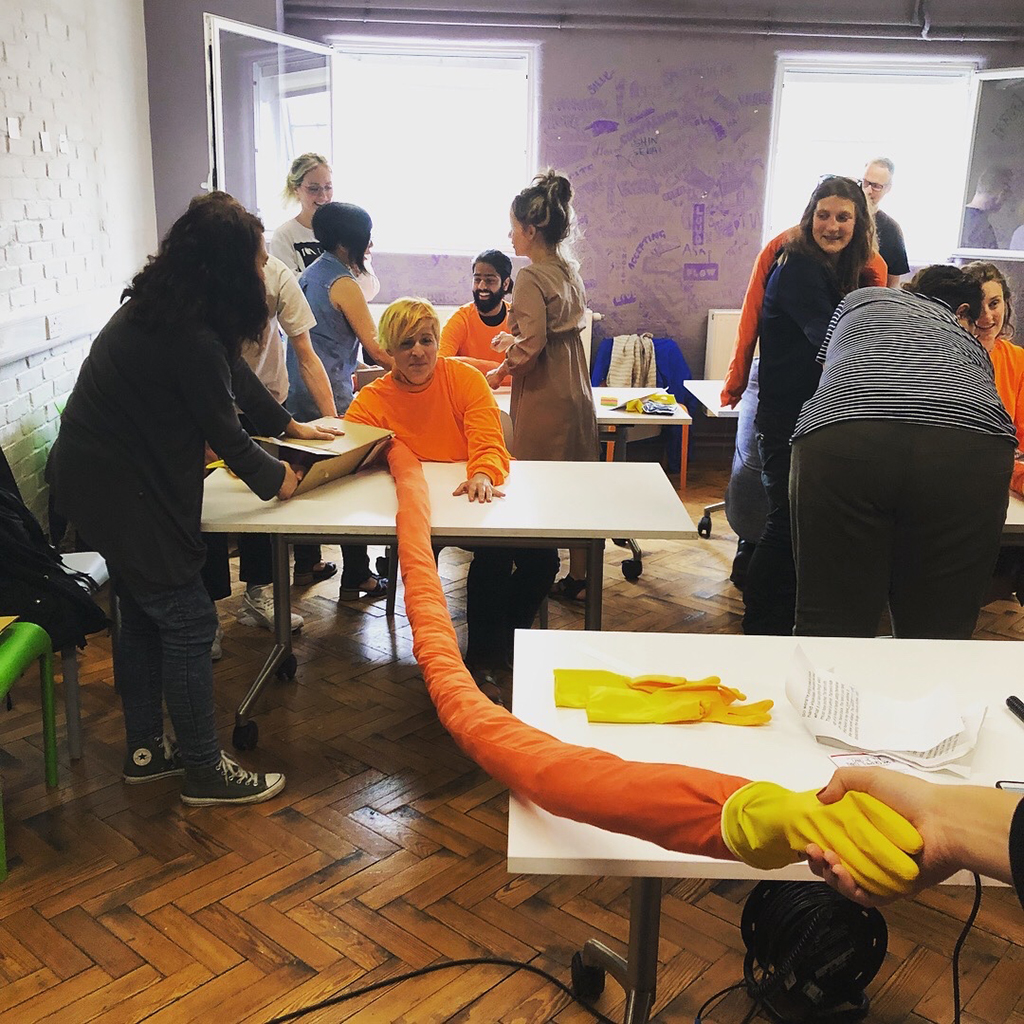
In the lead up to Furtherfield’s Playbour: Work, Pleasure, Survival exhibition Maria Dada, Miranda Hall and Cassie Thornton will be taking over the social media channels on Twitter, Instagram, and Facebook. Each micro-commission is an online space to take in different directions related ideas and themes of #playbour.
Our first week kicks off with Maria. Researcher in the fields of design and material culture, Dada’s Confessional Viral Hoax Engine brings together an interest in the infrastructures and processes used to spread misinformation online with themes of transparency, anxiety, and virtue signalling.
The second week is headed by Miranda Hall, who is a freelance journalist and research assistant at SOAS specialising in digital labour.
In the final week Cassie Thornton, artist, activist and feminist economist, will take-over Furtherfield’s social media channels. You can learn more about her here and her new project being launched on Kickstarter. Her take-over explores ideas surrounding yoga, feminist economics, class war, collective revenge, and social technology.
Dani Admiss is an independent curator and researcher working across art, design, and networked cultures. Her work employs world-building and co-creation to explore changes happening to our social, technological, and ecological, contexts. She is particularly interested in working with others to understand not yet completed transformations of body, society, and earth, into global capitalist systems. She is Founder of Playbour: Work, Pleasure, Survival, an art and research platform dedicated to the study of the worker in an age of data technologies. daniadmiss.com
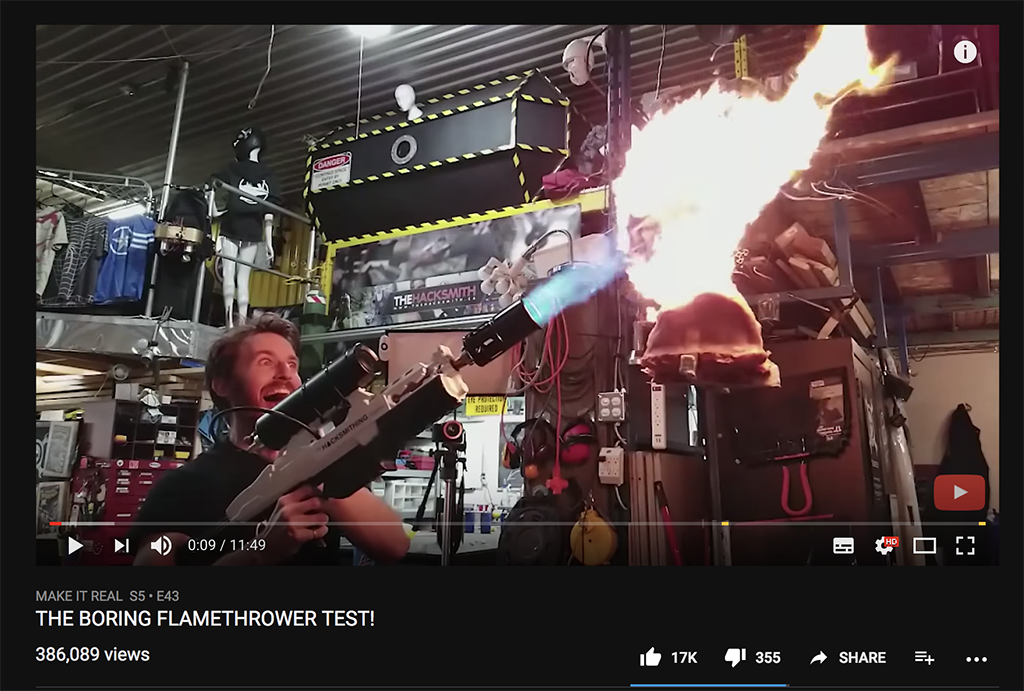
Furtherfield is an internationally renowned arts organisation specialising in labs, exhibitions and debate for increased, diverse participation with emerging technologies. At Furtherfield Gallery and Furtherfield Lab in London’s Finsbury Park, we engage more people with digital creativity, reaching across barriers through unique collaborations with international networks of artists, researchers and partners. Through art Furtherfield seeks new imaginative responses as digital culture changes the world and the way we live.
Furtherfield Gallery
McKenzie Pavilion
Finsbury Park, London, N4 2NQ
Visiting Information
This project would not have been possible without the kind support of our partners.
This project has been funded with the support from the European Commission. This communication reflects the views only of the author, and the Commission cannot be held responsible for any use which may be made of the information contained therein.
Playbour: Work, Pleasure, Survival, is realized in the framework of State Machines, a joint project by Aksioma (SI), Drugo More (HR), Furtherfield (UK), Institute of Network Cultures (NL) and NeMe (CY).
In partnership with AntiUniversity
Whether you smelt it, mine it, burn it, breathe it, or shove it up your ass the result is the same: addiction.
Addiction is defined as a chronic, relapsing earthly disease that is characterized by compulsive seeking and use of earth products, despite harmful consequences. It is considered a brain disease because humankind changes the earth—they change its structure and how it works.
Soft Sickness is a one evening/one day workshop hosted by the research project Shift Register exploring the signs, symptoms, circulations, exchanges, consumptions, dependencies, and management implicit in the multifarious and pathological dependence on the earth which is now named by that word “Anthropocene”. Earthly addictions produce quantified-earth self-portraiture, GIS co-dependencies, and all other variants of planetary narcissism. Earth-scale sensor systems and media networks, swathing the planet in information about itself, are unveiled with media from on- and off-planet earth science field-stations and reflections thereupon. Dependencies bring anxieties about the impending doom of resource dearths to come. People manage these anxieties with new psychotropic medications, whereas artists represent and markets bet on them, against the health of the earth and its living bodies.
Soft Sickness divines the earth lines of the often contradictory ingestion of and repeating addiction to the earth and its productions, data, memory — its circulations, seasons and natures, to the plants, the mushrooms and the animals, to fossil fuels, metals, to liquid screens and smogged surfaces, to longevity and, finally, to the real. To the thing and things which we cannot help doing (things to). To compulsively consume (the earth) is to eat and subsequently to excrete ourselves, humankind, and this cycle can be termed addiction. We feed from the earth, feeding back to the earth a world and mind-changing chemistry.
During the workshop, participants and invited guests will discuss, map, extract, ingest and excrete relations of local earth manifested in Finsbury Park in North London. Plant and pharmaceutical toxicities/ psycho-pharmacologies, poison cures, geophagic gastronomics, esoteric pollution sensing and embrace, and the invention and embedding of folkloric and human to non-human ecologies constitute parts of this invitation. We will gather psycho-active dew, imagine tales for the mole people, bake bread for crows, and make the earthworlds flesh.
We wish to develop contemporary rituals articulating the polarised and overgrown junk-tions of shamanic spirit journeyings with addiction managements; cold kicking the earth habit or indulging absolutely in the (cannibal/capital) undergrounds and (fairie) overgrounds.
SHIFT REGISTER is a research project investigating how technological and infrastructural activities have made Earth into a planetary laboratory. The project maps and activates local dynamics and material shifts between human, earthly and planetary bodies and temporalities. Contemporary, mainstream science and technology are intersected with other knowledge systems to attempt a reconfiguration of relations between humans and the earth. SHIFT REGISTER is Jamie Allen, Martin Howse, Merle Ibach, Jonathan Kemp and Martin Sulzer at the Critical Media Lab, Basel.
SEE IMAGES FROM THE WORKSHOPS
Part of the Poetry for Animals, Machines and Aliens: The Art of Eduardo Kac exhibition at Furtherfield Gallery
Families and groups of all ages are invited to design their own giant rabbits and to draw them on Finsbury Park by walking your own rabbit route using GPS software.
Taking about an hour, it will be a fun and creative time for all involved as we all work together with artist Michael Szpakowski to draw the rabbit and walk it for it to be added to the Finsbury Park map. Participants will be credited on a final image of all the rabbits created in the park.
Just turn up on the day to book a place for your group – workshop places will be offered on a first-come first-served basis on each day.
Groups and families can also just turn up on each day to join in with the fun and walk some bunny routes in the park.
Furtherfield Gallery
McKenzie Pavilion
Finsbury Park, London, N4 2NQ
Visiting Information
10:30 – 14:00 – Ruth Catlow and Max Dovey
Artists Organise (on the blockchain) is the fourth event in the DAOWO blockchain laboratory and debate series for reinventing the arts.
In previous workshops, hosted by Goethe Institut London, we have explored developments in the arts ecosystem, impacts on identity, and the complex considerations involved in formalising systems for “doing good” on the blockchain.
In this special event hosted by Drugo More in Rijeka we will draw on the Croatian cultural context and attempt to envision, devise and test alternative forms of blockchain-based cultural production systems, for application at Furtherfield in London. This workshop is part of a wider programme events in Rijeka to accompany the opening at Filodrammatica Gallery of the touring exhibition New World Order.
Set up in 2002, the pioneering non-profit Croatian initiative Clubture“aims to empower the independent cultural sector”, organising according to decentralised, participatory principles that resonate with claims made for blockchain governance.
Together we will explore what lessons can be learned from the radical, decentralized, participatory organising principles developed by both Furtherfield and Clubture, when assessing the potential value of blockchain technologies to instigate collaboration between networks of cultural players? How do the affordances of different blockchain value systems impinge on our ideas of human nature, and the value and limitations of existing cultural institutions and networks? Who are the networks’ users? How does the network deal with inequalities of resources (time, money, reputation etc)? How are decisions made, rules enforced and conflict resolved?
Number of participants is limited. You can apply for the workshop by e-mail to dubi<at>drugo-more.hr, until 12 February.
Using theatre, improv and role play techniques participants will develop the following premise:
Julian Oliver’s Harvest node has been installed on top of Furtherfield Gallery in Finsbury Park. A wind turbine is generating a small amount of electricity that is powering the graphics card to mine the ZCash cryptocurrency. It is suggested that the surplus value generated by the work should operate as the funding faucet for a body that commissions new environmentally focused cultural practices and projects for and with the visitors to the park where it is based.
Using the Harvest ´fund´, workshop participants will develop a new public artwork proposal that can commission a cultural program in Finsbury Park. The artwork aims to establish a ´headless´ organisational structure that is financially sustainable and incorporates various actors into the cultural program. The aim is to gain ‘real-world’ understanding of how different blockchain value systems may afford alternative social structures for collaborative cultural production.
Ruth Catlow
Ruth Catlow [UK] is an artist, curator, and writer. She is co-director, of Furtherfield, co-founded with Marc Garrett in 1996, an artist led organization for labs, debates and exhibitions around critical questions in arts, technology and society. She has co-devised the ‘DAOWO’ workshop series with Ben Vickers (Serpentine Galleries) & in collaboration with Goethe-Institut London (Oct 2017- Mar 2018). Catlow is named by the Foundation for P2P Alternatives in their list of 100 women Co-creating the P2P society.
Max Dovey
Max Dovey [UK] can be described as 28.3% man, 14.1% artist and 8.4% successful. He is also an artist, researcher and lecturer specialising in the politics of data and algorithmic governance. His works explore the political narratives that emerge from technology and digital culture and manifest into situated projects – bars, game-shows, banks and other participatory scenarios. He holds a BA Hons in Fine Art: Time Based Media and a MA (MDes) in Media Design from Piet Zwart Institute. He is an affiliated researcher at the Institute of Network Cultures and regularly writes for Open Democracy, Imperica & Furtherfield. His work has been performed at Ars Electronica Festival, Art Rotterdam & many U.K based music festivals.
The DAOWO programme is devised by Ruth Catlow (Furtherfield) and Ben Vickers (Serpentine Galleries & unMonastery) in collaboration with the Goethe-Institut London, and the State Machines programme.
This project has been funded with the support from the European Commission. This communication reflects the views only of the author, and the Commission cannot be held responsible for any use which may be made of the information contained therein.
13.30 – 17.30 – Kei Kreutler, Sarah Meiklejohn, Laura Wallis, Jaya Klara Brekke
Doing Good (on the blockchain) is the third event in the DAOWO blockchain laboratory and debate series for reinventing the arts.
In previous workshops we have probed ideas focusing on developments for blockchain application in the arts and the role of identity within the blockchain ecosystem.
Citizen groups that engage in activism and ‘doing good’ are generally structured around informal economies which rely on a certain degree of flexibility, improvisation and indeterminacy of activity. The introduction of technical systems can have a flattening effect that removes all contingency from a system. It sets distinct rules under which an activity or exchange can take place. These rules however can be somewhat opaque, shaped by the affordances of technologies rather than the needs of its users. This event aims to examine what is at stake in the formalisation of ‘doing good’ under blockchain systems for decentralised trust. We will look at how informal systems (e.g. for organising migration from war zones to stable territories) are forced into a formalised rule based structure, while formal systems for public good (eg distribution of social welfare) may exacerbate issues of both exclusion and monitoring. We consider design for contingency, and identify what must be left out.
The Right Systems For The Job?
Sarah Meiklejohn will set the scene sharing her research into developments in systems of decentralised trust, openness and visibility in finance, supply chains, and managing personal data.
This will be followed by 3 provocations that will inform discussion and debate:
Increased Engagement & Resisting De-facto Centralisation
Jaya Klara Brekke on the affordances of Faircoin blockchain technology, exploring its use as a redistribution of what is possible, and for who – extending and reconfiguring spaces and modes of politics.
Incentives for Participation
Laura Willis, on the work of Citizen Me – a platform that promotes the understanding of the value of personal data through notions of citizenship.
Behaviour under Transparency
Kei Kreutler (Gnosis) on blockchain’s potential ability to encode and incentivize social behavior, both on- and off-chain, and designing for unforeseen consequences. How does the figure of the good—politically and aesthetically—influence the uptake of “new” technologies, and how do staked predictions influence the present?
This workshop is devised by Ruth Catlow (Furtherfield) and Ben Vickers (Serpentine) in collaboration with Goethe-Institut London and in partnership with Dr Sarah Meiklejohn from UCL, as part of the research project Glass Houses – Transparency and Privacy in Information Economies.
Sarah Meiklejohn
Sarah Meiklejohn is a Reader in Cryptography and Security at University College London. She has broad research interests in computer security and cryptography, and has worked on topics such as anonymity and criminal abuses in cryptocurrencies, privacy-enhancing technologies, and bringing transparency to shared systems.
Jaya Klara Brekke
Jaya Klara Brekke writes, does research and speaks on the political economy of blockchain and consensus protocols, focusing on questions of politics, redistribution and power in distributed systems. She is the author of the B9Lab ethical training module for blockchain developers, and the Satoshi Oath, a hippocratic oath for blockchain development. She is based between London, occasionally Vienna (as a collaborator of RIAT – Institute for Future Cryptoeconomics) and Durham University, UK where she is writing a PhD with the preliminary title Distributing Chains, three strategies for thinking blockchain politically (distributingchains.info).
Laura Willis
Laura Willis works as Design Lead in user experience at CitizenMe. Alongside this work Laura is also very passionate about illustration and won an award for Macmillan children’s books before she graduated from University of the Arts, London.
Kei Kreutler
Kei Kreutler is a researcher, designer, and developer interested in how cultural narratives of technologies shape their use. She contributes to a range of projects—from the networked residence initiative unMonastery to the augmented reality game for urban research PATTERNIST—related to organizational design and practice. She is Creative Director at Gnosis, a forecasting platform on the Ethereum blockchain, and lives in Berlin.
The DAOWO programme is devised by Ruth Catlow (Furtherfield) and Ben Vickers (Serpentine Galleries & unMonastery) in collaboration with the Goethe-Institut London, and the State Machines programme.
This project has been funded with the support from the European Commission. This communication reflects the views only of the author, and the Commission cannot be held responsible for any use which may be made of the information contained therein.
14.00-17.30 – Workshop devised and hosted by Ruth Catlow and Ben Vickerswith Ramon Amaro, Ed Fornieles Thor Karlsson & Emily Rosamond
19.00-20.30 – Screening of the documentary My Name is Janez Janša (2012) Introduced by Ruth Catlow and Janez Janša
Identity Trouble (on the blockchain) is the second event in the DAOWO blockchain laboratory and debate series for reinventing the arts.
Identity is considered one of the hardest problems in the blockchain space, as it is here that it really matters how human and machinic systems connect. With the potential to fix and potentially impinge upon the relationship between our subjective sense of self, freedom to use multiple identities and our machine-assigned identities.
These difficulties span personal, social, technical and political domains. From a global perspective, blockchains have begun to be put forward as the most efficient and secure solution for providing identification to refugees and with it, access to basic social infrastructure such as healthcare, voting, financial and legal rights and services. As steps towards both national identity and global identity systems are being accelerated, perhaps most notably in Goal 16 of the UN 20 Global Goals, as being; “By 2030, provide legal identity for all, including birth registration”.
These drives sit in tension with fears about the increasing convergence of political and commercial control through identity technologies, tensions between: name and nym; person and persona; privacy, transparency and security; and the interests of the private individual and public citizen. All of which run counter to the proclamation that “Having two identities for yourself is an example of a lack of integrity”.
At the first DAOWO workshop we discovered more about current developments for blockchain application within the arts. At this event we seek to further challenge and reconsider the identity question in the context of the arts-blockchain ecosystem.
This workshop will be opened with a keynote by developer Thor Karlsson who will present Authenteq, an automatic identity verification platform and discuss his company’s approach to design for “trust and transparency in communications and transactions between users”.
This will be followed by a series of provocations by theorists and arts practitioners on cultural identity jamming, dangerous bias in the datasets that inform machine learning, and decentralised reputation management.
Laying foundations for the workshop in which we will work together to develop new stories about a set of characters living in the arts. How they operate and feel differently as the impact of blockchain technologies takes effect on their personal and professional role within the artworld.
Join us to describe what will go wrong? And what might just work?
“The system of reference of names started to crack … This made me reflect on issues such as identity vs identification, multiplicity vs multiplication, the name as an interface between the private and the public, and the personal name as a brand.” – Janez Janša, Director of My name is Janez Janša
Following the second workshop of the DAOWO series we present this film about names, identity and pseudonymity in a long history of academic, artistic and popular identity play for political and personal reasons. In 2007 three artists changed their names to that of Janez Janša, the then Prime Minister of Slovenia, whilst remaining ambiguous about their reasons. This documentary film reflects on the subjective and public meaning and utility of a person’s name and documents the interpretations and responses provoked by journalists, the general public and the “original” Janez Janša.
The Janez Janša® exhibition is on display at Museum of Contemporary Art Metelkova, Ljubljana
18 October 2017 — 08 February 2018
Ramon Amaro
Ramon Amaro is a Lecturer in Visual Cultures at Goldsmiths, University of London; Research Fellow in Digital Culture at Het Nieuwe Instituut in Rotterdam; and visiting tutor at the Royal Academy of Art, The Hague. Ramon has worked as a former Assistant Editor for Big Data & Society (SAGE), quality design engineer for General Motors, and programmes manager for the American Society of Mechanical Engineers (ASME). His research interests include philosophy, machine learning, and black study.
Ed Fornieles
Ed Fornieles is an artist whose works are responsive to the movement of information. Fornieles uses film, social media platforms, sculpture, installation and performance to express the interaction of family, relationships, popular memes, language and the subcultures of 21st century experience. His work operates within the logic of immersive simulations, which construct and enact alternative political and social spaces. His projects often involve cultural, social, and infrastructural production, making interventions that reconfigure the viewer’s position and sense of self.
Thor Karlsson
Thor Karlsson is the lead backend developer at Authenteq, a privacy tool and identity verification platform for online services. With over six years of professional experience in .NET and Java, Thor works in backend systems with an emphasis on clean code, testability and optimization. Thor is currently focused on implementing core backend systems used for the Authenteq ID verification and face recognition platform.
Emily Rosamond
Emily Rosamond is a Canadian artist, writer and educator. She completed her PhD in 2016, as a Commonwealth Scholar in Art at Goldsmiths, University of London. She is Lecturer in Visual Cultures at Goldsmiths, and Joint Programme Leader on the BA Fine Art & History of Art. She exhibits individually and with the collective School of The Event Horizon.
The DAOWO programme is devised by Ruth Catlow (Furtherfield) and Ben Vickers (Serpentine Galleries & unMonastery) in collaboration with the Goethe-Institut London, and the State Machines programme.
This project has been funded with the support from the European Commission. This communication reflects the views only of the author, and the Commission cannot be held responsible for any use which may be made of the information contained therein.
This series brings together artists, musicians, technologists, engineers, and theorists to join forces in the interrogation and production of new blockchain technologies.
Our focus will be to understand how blockchains might be used to enable a critical, sustainable and empowered culture, that transcends the emerging hazards and limitations of pure market speculation of cryptoeconomics.
Intended as a temporary laboratory for the creation of a living laboratory, the inaugural workshop in the series takes a pragmatic approach towards building technical and economic capacity in the arts.
As the DAOWO series unfolds, each lab will work across a spectrum of themes and domains of expertise, breaking down silos and assumptions about what blockchain technologies might mean. The aim is to birth a new set of experimental initiatives which can reinvent the future of the arts as we know it.
Thu 26 Oct: Reinventing the Art Lab (on the blockchain)
Venue: Goethe-Institut, London | BOOKING ESSENTIAL
2-5.30pm Workshop devised and hosted by Ruth Catlow and Ben Vickers
7-8.30pm Panel discussion with Hito Steyerl, Helen Kaplinsky, Julian Oliver
The Subsequent DAOWO Programme of Labs and Debates
Thu 23 Nov: Identity Trouble (on the blockchain)
Thu 25 Jan 2018: Doing Good (on the blockchain)
Fri 16 Feb 2018: Artists Organise (on the blockchain) (special event with Clubture at Drugo More, Rijeka)
Thu 22 Feb 2018: The Decentralised Music Society reforming music (on the blockchain)
Thu 29 Mar 2018: What Will It Be Like When We Buy An Island (on the blockchain)?
This programme is devised by Ruth Catlow and Ben Vickers in collaboration with the Goethe-Institut London, and the State Machines programme. Its title is inspired by a paper by artist hacker and writer Rhea Myers called DAOWO – Decentralised Autonomous Organisation With Others.
Events will be hosted at the Goethe-Institut, London and Drugo More, Rijeka.
About Ruth Catlow
Ruth Catlow is an artist, writer and curator working with emancipatory network cultures, practices and poetics. She is the co-founder, co-director of Furtherfield.
About Ben Vickers
Ben Vickers is a curator, writer, explorer, technologist and luddite. He is CTO at the Serpentine Galleries in London and an initiator of the open-source monastic order unMonastery.
This project has been funded with the support from the European Commission. This communication reflects the views only of the author, and the Commission cannot be held responsible for any use which may be made of the information contained therein.
You are invited to join us for a research workshop responding to the Are We All Addicts Now? exhibition at Furtherfield Gallery.
The visual matrix is a new psychosocial research technique that we are using to generate audience response to the project. Vanessa Bartlett has written a blog about this fascinating curatorial research process which is designed to test how a broad range of arts, science and technology audiences respond to interdisciplinary arts projects. Content generated during this session will inform our evaluation of Are We All Addicts Now?
Participants will be invited to view the exhibition at Furtherfield Gallery. Then, over the course of 45 minutes, participants will engage in a process of generating images and associations related to their experience of the work that they have seen. You will be seated throughout, engage with other participants and be encouraged to provide verbal associations if and when you are comfortable speaking. The visual matrix will be audio recorded. Following this there will be a short break and a second session lasting 45 minutes where participants will be asked to consider the images and associations generated by the group in a discussion. Optional five-minute ‘exit interviews’ with individual participants will take place at the end of the process.
Our research team will study the material that we have recorded. Anonymised excerpts will be used for further research and publication including conference and journal articles.
If you are interested in participating please contact v.bartlett [at] unsw.edu.au for more information.
The visual matrix method was created and developed by Lynn Froggett and her team at the Psychosocial Research Unit at University of Central Lancashire.
Research Team: Dr Elizabeth Muller and Miss Vanessa Bartlett, UNSW Australia. Ethics Approval No: HC16612
Email v.bartlett [at] unsw.edu.au to book your place.
Furtherfield Gallery
McKenzie Pavilion
Finsbury Park, London, N4 2NQ
Visiting Information
Part of the NEW WORLD ORDER exhibition at Furtherfield Gallery
BOOKING ESSENTIAL – Limited places available for this FREE workshop
A day of design-based research using the GeoCoin platform to explore novel ways of reconsidering and reinventing currency through location-specific value transactions. How can money be reprogrammed to interact with or react to everyday practices of value exchange in and around the city? Explore these and more questions with the Design Informatics team from the University of Edinburgh.
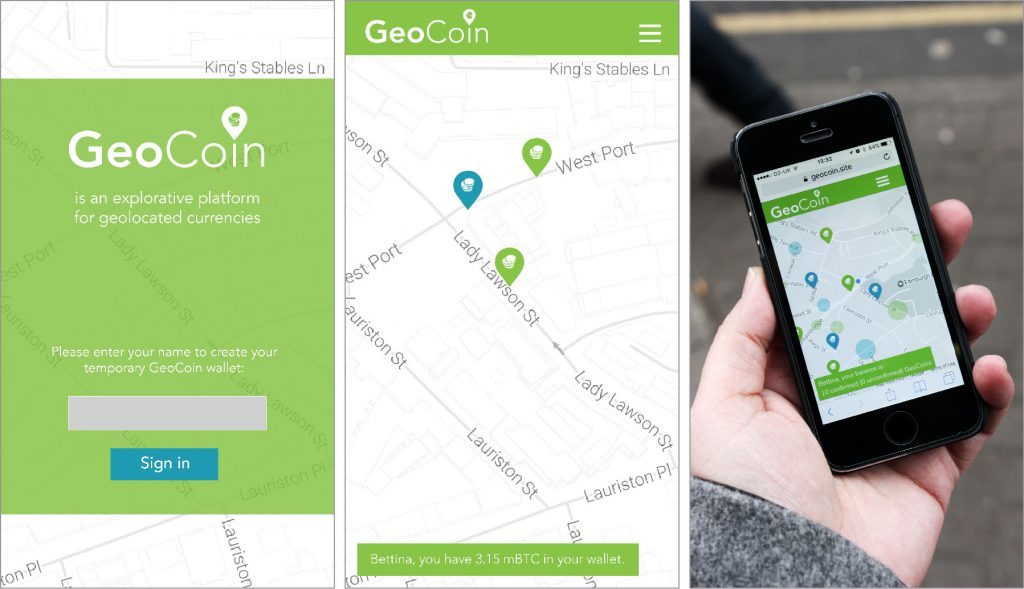
This workshop is part of the ESRC funded research project After Money lead by Design Informatics at the University of Edinburgh.
Saturday 24 June, 11-1pm and 2-4pm, Furtherfield Gallery
Ever wanted to join your partner in bitcoin matrimony? Or wanted to join another partnership for a short time only? You’ve come to the right place. For this day only, you can record your short-term bitcoin union via Handfastr on the blockchain in an immutable and ever growing ledger of bitcoin marriages at the Furtherfield Gallery.

This project is part of the ESRC funded research project After Money lead by Design Informatics at the University of Edinburgh.
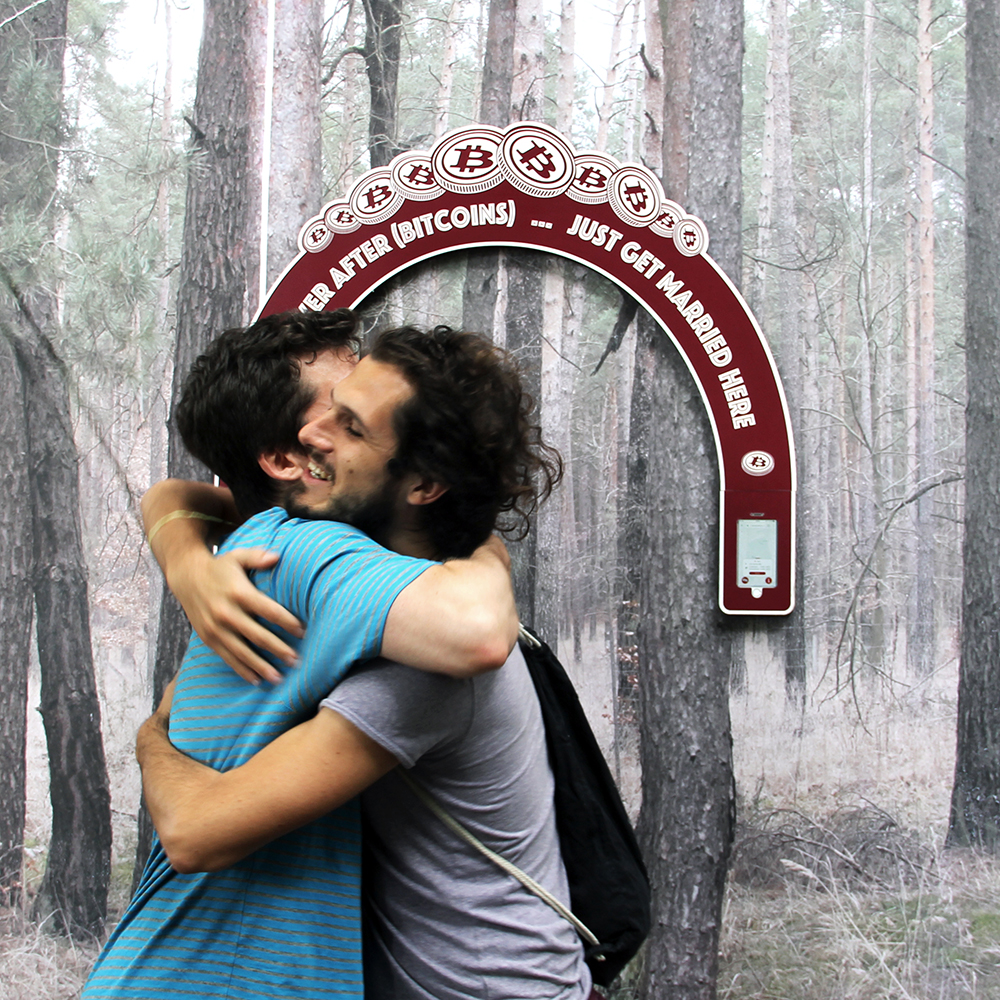
Part of the NEW WORLD ORDER exhibition at Furtherfield Gallery
BOOKING ESSENTIAL – Limited places available for this FREE workshop
In partnership with Antiuniversity Now 2017
As demonstrated by the works in the NEW WORLD ORDER exhibition at Furtherfield Gallery, blockchain technologies and cultures display a remarkable capacity to embody the interests of diametrically opposed political ideologies. Manpowertop looks more widely at the subject of Silicon Valley companies and how their promotional media envisions “the future” of their technology’s role in society.
The recent publication of Mark Zuckerberg’s open letter, titled Building Global Community, has drawn debates about the accelerationist politics of Silicon Valley into the public sphere once again. The seductive message of the manifesto itself is unsurprising, and is typical of the glossy promotional media released by other tech companies: We are told that new technologies can facilitate greater social inclusion, foster democratic grassroots political movements, and allow us to be more productive in our labour and leisure. While such media are often renderings of some notional “future” existence, what might they reveal about the ways we delimit our understanding of the present? Additionally, what would have to happen between “now” and “then” for these visions to be fully realised?
Manpowertop is a workshop that takes these questions as a starting point, challenging participants to diagnose the power relations in these branded visions of the future. Participants will adopt “troubleshooting” as a critical framework for enquiry, and produce diagrammatic readings of these speculative technologies, the networks they interlink with, and their associated politics of usership. In doing so, we will collectively identify what is left out of these visions, and explore how these omissions might offer an insight into the power relations that exist between users and technological platforms in the present.
Network Diagnostics is the collaborative research practice of Niall Docherty and Dave Young, focused on using technical models of “troubleshooting” as a mode of critically engaging with digital culture.
Niall Docherty is a PhD candidate at the Centre for Critical Theory at Nottingham University. His project attempts to combine the empirical foundations of software studies and Foucauldian governmentality to analyse Facebook within the neoliberal context of its inception and current use. He has completed two degrees at Goldsmiths – a BA in Politics in 2014, and an MA in Cultural Studies the following year. Niall was born and currently lives in Sheffield, ‘the greenest city in Europe’ according to some sources.
Dave Young is also a PhD candidate at the Centre for Critical Theory at Nottingham University, and is currently researching bureaucratic media and systems of command and control in the US military since the Second World War. His practice takes the form of workshops, talks, texts, and website development, and he has presented work for organisations such as the Disruption Network Lab, Transmediale, Servus, and Furtherfield. An archive of past/ongoing work can be found at dvyng.com.
BOOKING ESSENTIAL – Limited places available for this FREE workshop
BOOK HERE
Furtherfield Commons
Finsbury Park, London, N4 2NQ
Visiting Information
Furtherfield Gallery is supported by Haringey Council and Arts Council England
LAB #4 in the Art Data Money series
Venue:Furtherfield Commons
BOOKING INFO: This event is for an invited group of participants. If you are interested in attending, please contact Furtherfield telling us about your interest in this area: ruth.catlow [at] furtherfield.org
A day-long workshop, led by independent curators and researchers Dani Admiss and Cecilia Wee, looking at how we are locked-into contemporary conditions that bring migration into being.
This workshop challenges participants to expand and rethink what potential responses to migration could be, creatively and beyond. How can we work with the technologies associated with migration (and their social effects) to inform and enact virtual mobility and cultural activism?
Thinking through ideas of art and social change, the day aims to unpick the abstract forces, the limited means we have to communicate them, and the dependency on automation, simulation, and capture to tell us the ‘truth’, but which escapes the importance of lived experience.
Over the course of a day we will produce a collaborative map that creatively challenges and proposes new ways of thinking about experiences of migration. We will physically engage with technologies associated with migration, this will be followed by discussions about migration using the ‘social technology’ of the World Cafe method. The day will end with a collaborative mapping exercise harvesting ideas and narratives from the day, which will be turned into a mini-publication to be publicly distributed, a record of collectively working together over a day.
As we come closer to COP21 in Paris, and in light of the recent media attention depicting an exodus of asylum seekers, refugees and migrants into Europe, we see that complex flows of power interlink fields of life like security, finance, health, climate and governance in contemporary globalisation, producing barriers to all forms of mobility. We propose that ‘technologies of migration’ instantiate themselves a new type of border, often geographically displaced and abstracted from our physical experiences of mobility. These technologies are subjects of social engineering, residing in websites and interview rooms, as well as more immediately perceivable ‘arrival infrastructures’ of e-border and immigration detention centres. Governments continue to seek ways to measure the political into policy. Expert devices, such as civic integration examinations, speech recognition technology, or European databanks of asylum seekers’ biometric data, map the phenomena of migration and mobility into knowledge practices, incorporating them into risk profiles and evidence-based strategies. For better of worse, the current migration controversy highlights the fundamentally problematic challenges to a humanist relationship to data and information.
‘The Migrant Machine’ is part of a broader research project, Ground Truth: an investigation into changing relations of how we come to see, sense and survey our world. Based on groundtruthing, the calibration process used by scientists and cartographers to anchor the map or model to the data collected from the reality of lived-experience, the project aims to think beyond mapping as a responsive but singular tool of resistance and collaboration and towards being-in-the-world as a continual form of responsibility and entanglement.
LAB #2 in the Art Data Money series
A weekend workshop, led by Dan Hassan of the Robin Hood Cooperative, focusing on the political/social relevance of Bitcoin, blockchains, and finance. All participants will be given some Bitcoin.
ADMISSION FEE: £10 for one day or £15 for the weekend*
The weekend workshop will take a historical look at the political / social relevance of Bitcoin (“Breaking the Taboo on Money”) by looking at the history of technical and social inventions the came before it. I’ll then futurecast what this could mean for the future of p2p finance (blockchains, new social architectures and peer owned platforms with a mix of synthetic finance, peer-owned-banks) and place Robin Hood Coop within this future (“Breaking the Taboo of Financial Markets”).
It will include hands on activities on covering topics such as blockchains (actually running them and understanding them) as well as dissecting financial instruments – such as Robin Hood Cooperative has been doing.
Day 1 – Breaking the Taboo on Money (focus on Bitcoin and blockchain):
11.00 Group introductions
11.30 Bitcoin, blockchains, finance – a series of quick 5 minute 101 introductions
11.30 – 13.00 Using Bitcoins whilst expanding our understanding of why this is so groundbreaking
13.00 – 13.30 Lunch
13.30 – 14.00 Recap
14.00 – 17.00 (with tea breaks) tbc
Day 2 – Breaking the Taboo on Financial Markets (focus on Robin Hood’s activities on Wall Street):
11.00 Group introductions
11.30 Bitcoin, blockchains, finance – a series of quick 5 minute one-to-one introductions (+ quick recap from the previous days session).
11.30 – 13.00 Emergent workshop from constellation of interests of those who turn up
13.00 – 13.30 Lunch
13.30 – 14.00 Recap
14.00 – 17.00 (with tea breaks) tbc
Part of Furtherfield’s Art Data Money programme.

– If you can’t afford the entry price, get in touch anyway and we can figure something out.
– All participants will be given some Bitcoin
– The workshop runs across two days. Both days will be complementary, but will also be standalone. there won’t be too much duplication for those who attend both, but you won’t be left behind if you only attend one.
Pre-reading / listening: Listen to as much of this talk by Vinay Gupta as you can.
Robin Hood Asset Management Cooperative is a cooperative owned and run by its members. At the moment we have over 500 members from 15 different countries and together we manage assets of about half a million euros. In the two years we have been active, we have created over 100,000 euros to our members and to our common pool. We disrupt the ordinary flows of money, share the loot, and invest the profits in the production and protection of commons.
More info: http://robinhoodcoop.org/
Dan Hassan (UK) is a computer engineer active in autonomous co-operatives over the last decade; in areas of economics (Robin Hood), housing (Radical Routes), migration (No Borders) and labour (Footprint Workers). He tweets as @dan_mi_sun
LAB #3 in the Art Data Money series
A weekend workshop, led by Brett Scott and The London School of Financial Arts, exploring different approaches to unveiling the financial sector – from open data mapping and photography to computer games and digital art installation pieces.
The financial sector is notoriously opaque and alienating to many people. It is cloaked in different forms of invisibility – either through secrecy and concealment, or through complexity, jargon and obscurity – and we often struggle to conceptualise how it works and how money moves.
Making the invisible world of global finance visible is a highly important task and there are a range of exciting projects attempting to do just that. In this two day workshop, we will explore different approaches to unveiling the financial sector, from open data mapping and photography to computer games and digital art installation pieces. We will look at new attempts at visualisation and sonification, and consider how money might be accurately represented in an era of digital payment via offshore tax havens.
Day 1 will be focused on explore, mapping and demystify the existing financial sector.
Day 2 we will work towards building an ‘Activist Bloomberg’. The Bloomberg Terminal is an expensive system that major banks use to get raw data and financial information. The Terminal is out of reach to most ordinary people, but can we create an open-source and open-access alternative Bloomberg to collect and distribute critical data on high finance? Let’s try!
Part of Furtherfield’s Art Data Money programme.

Finance is viewed as a niche area characterised by numbers, complex graphs, and professionals wielding obscure techniques, but the sector is in fact underpinned by human relationships, power dynamics and philosophical concepts that we all intuitively understand. Realising this is a great step towards keeping the financial commons open. At its core The London School of Financial Arts is about experiential learning, offering fun, adventurous, and experimental courses that immerse campaigners within the financial dark arts.
More info: http://lsfa-hackspace.cc/
Brett Scott (UK) is campaigner, former broker, and the author of The Heretic’s Guide to Global Finance: Hacking the Future of Money (Pluto Press). He blogs at suitpossum.blogspot.com and tweets as @suitpossum
Park visitors of all ages… Free your office scanner and get your creative juices flowing in Finsbury Park this Summer!
Join us to build a collective portrait of Finsbury Park to be shown at Furtherfield Gallery and in an online exhibition.
With Furtherfield’s artist in residence, Carlos Armendariz, you will create intriguing images of the park with hacked scanners inspired by the Rippling Images of commissioned US artist Nathaniel Stern.
All are welcome, including children with their guardians. The workshops are free but BOOKING IS ESSENTIAL. Click here to book any of these dates:
tweet your images using #wescanfinsburypark
Nathaniel Stern has been using hacked desktop scanners to create beautiful images for over a decade. As part of the exhibition Beyond the Interface – London, he hung 21 large scale prints outside of the Furtherfield Gallery and produced a complete new series of images available online: Rippling Images of Finsbury Park.
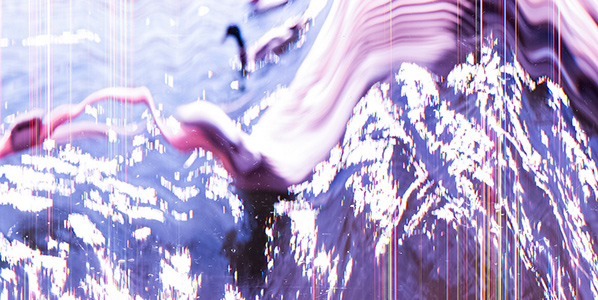
Stern hacks desktops scanners to transform them in portable image capturing devices, and uses them to “perform images into existence”. This process create interesting connections between his body, the scanned environment, and their movement at the time of capturing. Stern himself explained his process in detail in his TEDx talk: Ecological Aesthetics.
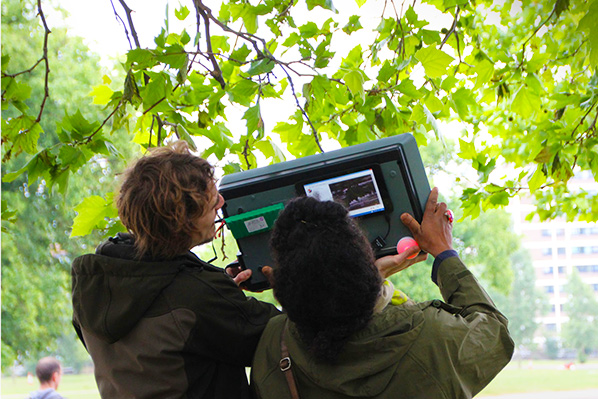
Now Furtherfield Gallery is offering a series of workshops for all ages which will allow the participants to experience Stern’s artistic process. You will learn how to hack a scanner and use one of the artist’s scanners to create your own images. The goal is to create a collective portrait of Finsbury Park and there is a chance to show your work in Furtherfield Gallery.
Furtherfield in partnership with MAT PhD programme, Queen Mary University. Pictures of the workshops by Alison Ballard.
Walkshop, making session and drop-in day
Come for one or both sessions, or just drop in for a chat about MoCC over tea and cake.
11am-1pm – Data Walkshop with data activist Dr Alison Powell (LSE)
Explore and discuss the data surveillance processes at play in Finsbury Park through a process of rapid group ethnography. Arrive from 10.30am at Furtherfield Commons for a short introduction to the project. We will leave at 11am for a 60 minute walk around the area followed by snacks and discussion. Please bring:
BOOK HERE (places limited to 12 on a first come first served basis)
2pm-4.30pm – Making session: LEGO Re-creations & Interactive Posters
Work with Cultural Geographer Dr Ian Cook to turn your commodity stories into activist LEGO re-creations. Inspired by Nathaniel Stern’s hacked scanner, artist Carlos Armendariz will help you translate your data findings into visual events. Produce arresting images for an interactive poster for public display, then track and count its impact.
You are welcome to bring your own smart phones and computers along.
BOOK HERE
This event is part of the research and development for the Museum of Contemporary Commodities, an art and social project led by artist Paula Crutchlow (Blind Ditch) and cultural geographer Ian Cook (Univeristy of Exeter).
More info: http://www.moccguide.net/
In partnership with The Arts Catalyst.
‘Living Assemblies’ is a hands-on workshop, led by designer and researcher Veronica Ranner, investigating the coupling of the biological material silk, with digital technologies. This workshop is organised by The Arts Catalyst in cooperation with Furtherfield.
We invite participants (experts in their own field – artists, designers, scientists, writers, technologists, academics, and activists) to join a weekend-long workshop, in which we will experiment with silk and a range of transient materials to imagine potential future applications for combining biological and digital media.
Traditional methods of crafting silk have barely changed in 5000 years, but recent explorations by scientists are uncovering extraordinary new potential uses for this material. Reverse engineered silk is one of the few biomaterials not rejected by the human body. Rather, able to be fully absorbed by human tissue, it allows for a range of applications within and interacting with the body, including human bone and tissue replacements, biosensors and biodegradable electronics, opening the potential to imagine new wearables and implantables with a range of functions.
During this two-day workshop, participants will collaboratively explore the potential of reverse engineered silk, currently confined to laboratories. Taking the body as the first site for investigation, Veronica will ask participants to consider themselves as living assemblies that can be hacked, enhanced, and patched into using bio-digital materials. Activities will involve material experiments combined with a narrative design process to speculate on silk’s possible future use in the world.
DAY 1
With Veronica Ranner, Clemens Winkler and Luke Franzke, participants will be introduced to transient materials — such as reversed engineered silk — through hands-on experimentation with a range of materials, including agar-agar, gelatine, fibroin, glucose and silk-fibres. They will use digital methods and circuits and combine them with silken materials, to then begin forming their own ideas into speculative objects and artworks.
DAY 2
Innovator, scientist and intermedia artist, Gjino Sutic will introduce the concept of ‘bio-tweaking’: improving and hacking living organisms, for example through metabolism hacking, neuro-tweaking, tissue engineering and organ growing. Participants will work together with science writer Frank Swain to construct narratives around their work. In the final session, participants will map out their ideas in discussion with the group.
If you would like to attend the 2-day workshop please send a statement of no more than 100 words and explain why you would like to attend and a brief summary of your background.
Deadline: 5pm, 18 May 2015
Please email: admin@artscatalyst.org
**Participants must be able to attend the full 2 day workshop**
**Please note spaces are limited**
Participants are encouraged to bring their own laptops, inspirational materials, tablets and cameras along, to enrich the tool set for story crafting.
Veronica Ranner is a designer, artist and researcher living and working in London. She researches the burgeoning domain of the bio–digital — a converging knowledge space where digitality and computational thinking meet biological matter. She dissects and creates tangible and immaterial manifestations of such collisions, examining hereby the polyphonic potential of alternative technological futures. Her current doctoral work explores paradigm shifts in reality perception by coupling speculative (bio)material strategies and information experience through design research. Veronica holds a degree in Industrial Design from Pforzheim University, a Masters in Design Interactions (RCA), and has worked trans-disciplinary with a variety of science institutions and biomedical companies, and she teaches and lectures internationally. Her work is exhibited internationally, including at the Israel Museum, Jerusalem (2012), Science Gallery, Dublin (2012), China Technology Museum, Beijing (2012), Ventura Lambrate, Milan (2013) and French Design Biennale, St. Etienne (2013). She is currently pursuing a PhD at the Royal College of Art’s Information Experience Design programme and is interested in complex networked cycles, emerging (bio-) technologies and biological fabrication, systems design, material futures and new roles for designers.
Clemens Winkler, designer and researcher at the Zurich University of the Arts, Switzerland.
Luke Franzke, designer and researcher at the Zurich University of the Arts, Switzerland.
Frank Swain, science writer and journalist.
Gjino Sutic, innovator, scientist and artist; Director of the Universal Institute in Zagreb, Croatia.
Other experts joining discussions during the workshops will be Bio-informatician Dr Derek Huntley (Imperial College).
The project is a collaboration between The Creative Exchange Hub at the Royal College of Art, Tufts University (Boston, MA), The Arts Catalyst (London), and Imperial College (London), and hosted and in collaboration with Furtherfield (London). The project is funded by the Arts and Humanities Research Council.
The telluro-geo-psycho-modulator is the latest experiment in a series of playful explorations and elaborations of a general thesis extracted from the neuroscientist Michael Persinger’s work, that our brain states are modulated by the interference patterns created by our immersion in natural weak geomagnetic fields, and that such patterns cause the feeling of “anomalous experiences” including those of ghosts or god.
The workshop aims to begin equipping participants with a method to explore such potentialities between the earth and our psyches through the construction of an experimental interface (developed with Martin Howse).
A short introduction (20 min) to participants will briefly cover the theory of weak geo-magnetic field effects on psyche, including demonstrating an entirely synthetic electronic amplifier/helmet configuration. This will ground participants in both the practical and playful nature of the project.
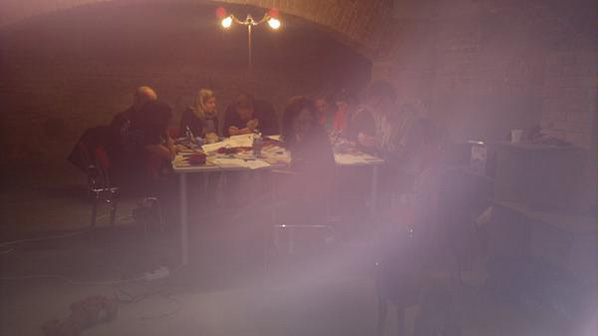
The brain is electro-chemical, and the existence of fundamental commonalities between all 7 billion human brains by which a similar physical stimulus can affect them is not a new concept – however, this workshop tests the idea that it is the induction by very low electromagnetic fields that disrupt a sense of self through the creation of anomalous experiences.
In the workshop particpants will build a simple circuit with which to test this thesis by connecting the earth’s telluric currents directly to our brains. On the second day we will then test the circuits outdoors in Epping Forest.
During the workshop and field trip participants will build electronic circuits and hand wind copper coils to construct:
The workshop is estimated to take around 4-6 hours for around 8 or so participants. All materials are supplied, however if participants have a soldering iron, please bring it along.
Each participant is asked to pay £15. This is to cover material costs – participants get to keep their circuits which can also be used with other circuits (eg. audio).
http://fossbox.org.uk/content/sex-and-security
A two-day event by Fossbox in collaboration with Furtherfield and Autonomous Tech Fetish around surveillance, gender and society. The event will consist of a practical privacy workshop followed by a day of discussion, making and performance. Open to everyone, women/LGBTQ especially welcome.
Practical workshop on privacy and security: 7 March, 11am
A focused exploration of the issues around sexuality, gender and surveillance. Visit this Meetup Group to join.
Discussion workshops – sex and surveillance: 22 March, 11am
A workshop using play, performance and discussion to develop a better understanding and a more collectivised civil response around these issues. Visit this Meetup Group to join.
If you’re hazy about how digital mass surveillance works and what you can do, you’ll get most out of it by attending both workshops. If you already know about the tech side, you might want to help out at the practical workshop!
The ‘Internet of Things’ (IoT) is heralded as a quantum leap in economy, society, culture and government — yet most people outside of the tech and creative industries struggle to get their heads around what this really means. A number of recent scandals involving ‘smart’ devices as well as Snowden’s revelations have highlighted the huge and slightly scary security and privacy issues at the heart of our brave, new, cyberworld. ICO and Offcom are acutely aware that this pervasive surveillance is making a mockery of current EU/UK privacy legislation which urgently needs an overhaul. Policy, however, prioritises rapid development of IoT over protecting sensitive data calling for ‘transparency’ rather than restriction of how our data can be collected and used. Meanwhile, the corporate and governmental chorus that law-abiding citizens have nothing to worry about from pervasive surveillance is wearing thinner every day.
As the digital domain begins to bleed into our ordinary, physical surroundings, the government is telling us that we don’t need privacy and even wants to outlaw the secure encryption which can protect our private life from being used for invasive profiling, ending up on public websites and social media, or on sale in the data black market. Cameron has stated that there should be absolutely no communication or data which the government can’t read. Is it really OK for corporations to compile and sell personal profiles so intimate that they know more about us than our loved ones do? Does the government really have a right to gather and keep our every private thought to be used in profiling if we ever do fall foul of the state for whatever reason? There is already a discussion of the ‘militarisation’ of social science and ‘predictive policing‘ – we’ve seen in the past which vulnerable groups are most likely to be targeted for profiling. What about the constant monitoring and manipulation of movement around cities. What if our government takes even more steps to the right whilst conditions get harder for most of the population. What if there were mass protests? What if a future right-wing government outside the EU decided to outlaw LGBTQ? What might these ubiquitous personal dossiers and pervasive control of urban space be used for then? Are we sleepwalking into a society where everyone is always-already a criminal and non-conformity or protest is no longer an option?
These developments are going to affect everyone but there are many issues around online security which will have particular resonances for women and queers and may affect us in very specific ways. There has been a lot of discussion and press about gender-trolling, ‘revenge porn‘, ‘gamergate‘ and Wikipedia, the ‘quantified self‘, FB real-names policy and binary sex dropdown lists in databases — to name but a few. However, there is not very much discussion about how these issues all fit together and what the overall impact of this production of digitised social space, hyper-self-awareness, and networked sexuality might be for women, queers, and marginalised groups. How does corporate and government surveillance and profiling affect our sense of self, our personal and public spaces, and our freedom to speak and organise with other women and queers? Where is the line between design which facilitates us and design which manipulates us?
The issues are hard to wrap your head around and keeping your private life private requires the commitment of a little effort — it can interrupt the manicured flow of our digital ‘user experience’. You might not really want to know what happens after you push the little button that says ‘send’ but staying safe online in 2015 and beyond is going to get a little bit more challenging. Not caring is going to be an increasingly risky option.
Technical solutions are needed, and a small army of ‘infosec’ practitioners, strong encryption, and hardened systems. However, this won’t be enough because USA, UK and EU governments are more concerned with corporate profits and the security of their own power than with the safety and wellbeing of civil society. Alongside our own private actions to secure our own data and the efforts of civil-society-hackers, non-profits and NGOs striving to keep us informed, skilled, and safe, we also need an aware and empowered civil society response. But is ‘smart’ economy an all-round bad idea purely to be defended against or is there the possibility of ‘smart’ technology and smart systems co-designed by and for women themselves and a respectful way to manage ‘big data’?
This is the fourth and final part of the Digital Futures: Money No Object series of events, conceived of in partnership with Furtherfield.
The session will be a currency prototyping brainstorm, where we will explore whether a currency or alternative exchange system might be developed for and by a distributed network of artists to support and promote experimental, open and free practices (on the understanding that anyone might call themselves an artist). Would it be a distributed cryptocurrency or networked version of a local currency? Could such a system generate, construct/create and circulate value?
It will be facilitated by Brett Scott, author of The Heretic’s Guide to Global Finance: Hacking the Future of Money, and will be followed by an evening public showcase of the work produced during this session.
PROTYPING WORKSHOP, 4pm – 6pm
Limited places, please contact Irini, i.papadimitriou(at)vam.ac.uk if you would like to attend
Evening Showcase from 6.30pm – 8.00pm
Please register here if you’d like to attend
This marks the conclusion of a series of stimulating discussions and presentations around alternative currencies and their politics by artists, creative technologists and theorists held at both the V&A and The White Building over the last few months. Topics have included technology on future currency and transactions as well as questions relating to how value may be manifested in years to come.
Money No Object is Heidi Hinder’s practice-based research project that took place at the V&A, supported by Creativeworks London and UnLtd. Money No Object is exploring the impact of technology on future currency and transactions as well as questions relating to how value may be manifested in years to come.
Digital Futures is a monthly meetup and open platform for the display and discussion of work by researchers and creative practitioners working with digital media, interactive art, digital design, science and more. Since October 2014 Digital Futures is being hosted and co-curated by The White Building. The White Building, run by SPACE, is an incubator for discursive and innovative thought, it serves as a testing ground and creative lab for artists and creatives whose work engages with technology.
Please register here if you’d like to attend the event. To attent the prototyping workshop please contact Irini at, i.papadimitriou(at)vam.ac.uk
The White Building
Queen’s Yard, White Post Lane
#Unit 7
E9 5EN London
United Kingdom
My Voice Means is a workshop that gives participants an opportunity to listen mindfully to the sound of their own voice, to discover the many layers of its meaning, and to discover how this process can be expanded by means of technology.
In a three hour session you will:
Cost: £20
To book a place visit http://tinyurl.com/mnwbj6h or contact info@contemplatech.net
Delivered by Contemplatech, a creative collaboration by Ron Herrema and Ximena Alarcón
Autonomous spaces, autonomous networks, boxes and forks – we invite all DIY lovers to come and join us for an afternoon of re-appropriation of networking technology to bypass the censorship and liberate our files.
What does a free culture look like? What is technology that supports it? For many years artists (among others) have been engaging with these questions, challenging restrictive laws and regulations as well as complex technical solutions. A new surge in search for practical solutions to file-sharing, easier to use and incorporate to our everyday life is the focus of this workshop. On the day we will install and use Piratebox and Librarybox on various devices to test their promise.
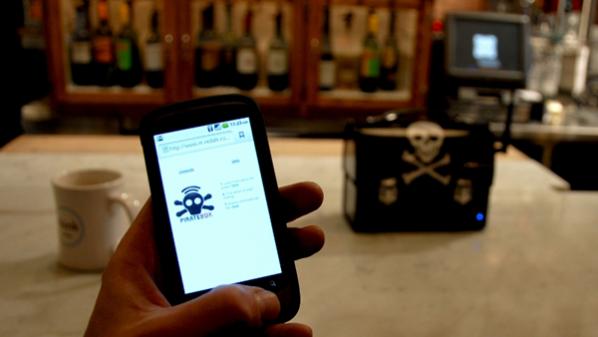
Inspired by pirate radio and the free culture movements, PirateBox utilizes Free, Libre and Open Source software (FLOSS) to create mobile wireless communications and file sharing networks where users can anonymously chat and share images, video, audio, documents, and other digital content.
Piratebox fork, LibraryBox is an open source, portable digital file distribution tool based on inexpensive hardware that enables delivery of educational, healthcare, and other vital information to individuals off the grid.
+ For more information about the event please contact Larisa Blazic.
Flossie is for women interested in using open source as coders, artists and social innovators. We run an annual conference and also regular events in London.
Furtherfield Commons
Finsbury Park
Near Finsbury Gate On Seven Sisters Road
E: info@furtherfield.org
Furtherfield Gallery is supported by Haringey Council and Arts Council England.
Codasign, in partnership with Furtherfield, will be running a new series of creative technology workshops for different ages at Furtherfield Commons, a hub to connect and activate local and international communities of artists, technologists, thinkers and doers.
Interactive Puppet and Story Workshop
Saturday 15 February 2014
10am – 12:30pm – 6-9 year olds
2-4:30pm – 9-12 year olds
Come and learn how to create your very own interactive hand puppet which tells you a story using Scratch and MaKey MaKey!
Create a Tron Hoodie
Sunday 23 February 2014
11am – 1pm
Upcycle your hoodie using electroluminescent wire.
Make Your Own Platform Game With Scratch
Saturday 1 March 2014
10am – 12pm – 6-9 year olds
1:30-4pm – 9-12 year olds
Learn how to create your very own platform based computer game in Scratch!
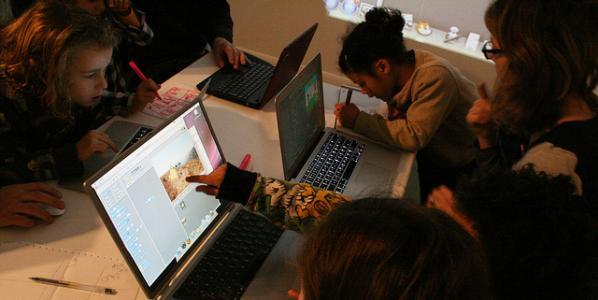
Miniature Circuit House
Saturday 15 March 2014
10am – 12pm – 6-9 year olds
1:30 – 3:30pm – 9-12 year olds
Wire up your own shoebox sized house using different electronic components which will be inserted into a circuit drawn with Bare Conductive‘s paint.
Soft circuit phone badge
Saturday 22 March 2014
10am – 1pm
Create a soft circuit badge which flashes when your phone receives a text message or is ringing.
Make a Musical Instrument with Paint, Scratch and MaKey MaKey
Saturday 24 May 2014
10am – 12pm – 6-9 year olds
1:30 – 4pm – 9-12 year olds
Come and learn how to make a conductive painting to control a musical instrument that you’ve created in Scratch and MaKey MaKey!
For more information and to book a place to any of the workshops please visit Codasign website.
All supporting material for the workshop will be available at learning.codasign.com.
VISITING INFO
Located by Finsbury Gate entrance on Seven Sisters Road
T: 0208 802 1301
E: info@furtherfield.org
+ See images from the event on flickr.
Part of the Movable Borders: Here Come the Drones! exhibition at Furtherfield Gallery.
In a post-national age, where “territorial and political boundaries are increasingly permeable”[1], what has become of the borderline? How is it defined, and what technologies are used to control it?
Movable Borders is an ongoing research project that begins to explore possible answers to these questions through facilitating discussions around the ‘reterritorialisation’ of the borderline in the information age. Participants are invited to investigate the use of cybernetic military systems such as remotely piloted aircraft (drones) and the Disposition Matrix, a dynamic database of intelligence that produces protocological kill-lists for the US Department of Defense.
The Reposition Matrix aims to reterritorialise the drone as a physical, industrially-produced technology of war through the creation of an open-access database: a ‘reposition matrix’ that geopolitically situates the organisations, locations, and trading networks that play a role in the production of military drone technologies.
During the workshop, participants will investigate the weapons industry and intelligence agencies that operate in the background of the drone campaigns ongoing in the Middle East. Information will be gathered through a diverse range of sources – from corporate publications to leaked document repositories. The information gathered during the research session will then be used as the basis for the collaborative development of a new world map: a diagram that exposes the complex networks of control and influence that exist at the core of the drone campaigns.
Cartographers, designers, artists, activists, political scientists, journalists, and anybody with a strong interest in understanding and discussing the materiality of the drone wars are invited to participate.
Participants will be able to gain an understanding of the geopolitical complexity of the war through collaborative research, discussion, and mapmaking sessions. Those who attend the workshop will also become contributors to an ongoing project – the formulation of an open-access database cataloging the information discovered during the series of workshops.
Furtherfield Gallery – Saturday 18 May 2013, 1-5pm
Visiting information
To book your place please contact Alessandra (Furtherfield).
Dave Young
Dave Young is an artist, musician and researcher currently studying the Networked Media course at the Piet Zwart Institute in Rotterdam, NL. His research deals with the Cold War history of networked culture, exploring the emergence of cybernetic theory as an ideology of the information age and the influence of military technologies on popular culture.
Furtherfield Gallery is supported by Haringey Council and Arts Council England.